 Horses are among the most common large animals in the Diamond Valley Lake fauna, and there are several skulls in various states of preservation in the Western Science Center collection. One of these skulls stands out, however, because of the strange way in which it was preserved.The skull, which was collected at the East Dam of Diamond Valley Lake, is shown above in ventral view; essentially, you're looking at the roof of the mouth. While it has been mostly cleaned, it's still in the original field jacket, so this how the specimen was preserved in the ground. This view shows the complete set of posterior teeth (premolars and molars) from both sides of the upper jaw; the left ones are labeled below:
Horses are among the most common large animals in the Diamond Valley Lake fauna, and there are several skulls in various states of preservation in the Western Science Center collection. One of these skulls stands out, however, because of the strange way in which it was preserved.The skull, which was collected at the East Dam of Diamond Valley Lake, is shown above in ventral view; essentially, you're looking at the roof of the mouth. While it has been mostly cleaned, it's still in the original field jacket, so this how the specimen was preserved in the ground. This view shows the complete set of posterior teeth (premolars and molars) from both sides of the upper jaw; the left ones are labeled below:  You may have noticed that, while there are a lot of teeth in this jacket, there is no bone. Now, teeth tend to preserve better than bones, since tooth enamel is tougher than bone. But in this case we have the complete, well-preserved upper posterior dentition - 12 tooth positions - all in their correct positions relative to each other, with no bone to hold them in place! This suggests that the bone was removed after the skull was buried; otherwise the teeth would have shifted out of position. The only explanation I've been able to come up with is that, after burial, the skull was exposed to sediment or ground water chemistry that caused the bone to dissolve while leaving the teeth untouched. Differential dissolution rates are not unusual in fossils, but I don't recall previously seeing an example in which the bone was completely dissolved while the teeth were apparently untouched.This strange preservational history does provide us with certain advantages. With the bones removed, we can see features of the dentition that would normally require X-rays or CT-scans. Notice that M3 has a different appearance than the other teeth. That's because it had not yet erupted when this horse died, and was likely still imbedded in the upper jaw. This also enables us to estimate the horse's age. In modern horses M3 typically erupts when the horse is 3 to 4 years old, and this M3 was not even close to erupting, so this horse was almost certainly between 2 and 3 years old, likely closer to 2. That also means that its deciduous (milk) premolars should still be in the mouth, with the permanent premolars still developing. So let's look at a side view of the left premolars:
You may have noticed that, while there are a lot of teeth in this jacket, there is no bone. Now, teeth tend to preserve better than bones, since tooth enamel is tougher than bone. But in this case we have the complete, well-preserved upper posterior dentition - 12 tooth positions - all in their correct positions relative to each other, with no bone to hold them in place! This suggests that the bone was removed after the skull was buried; otherwise the teeth would have shifted out of position. The only explanation I've been able to come up with is that, after burial, the skull was exposed to sediment or ground water chemistry that caused the bone to dissolve while leaving the teeth untouched. Differential dissolution rates are not unusual in fossils, but I don't recall previously seeing an example in which the bone was completely dissolved while the teeth were apparently untouched.This strange preservational history does provide us with certain advantages. With the bones removed, we can see features of the dentition that would normally require X-rays or CT-scans. Notice that M3 has a different appearance than the other teeth. That's because it had not yet erupted when this horse died, and was likely still imbedded in the upper jaw. This also enables us to estimate the horse's age. In modern horses M3 typically erupts when the horse is 3 to 4 years old, and this M3 was not even close to erupting, so this horse was almost certainly between 2 and 3 years old, likely closer to 2. That also means that its deciduous (milk) premolars should still be in the mouth, with the permanent premolars still developing. So let's look at a side view of the left premolars:  Here's an annotated version:
Here's an annotated version: As expected, the permanent premolars were still developing when this horse died, and are present beneath the deciduous premolars (actually above them, since this is the upper jaw sitting upside down). Their presence also helps refine our age estimate, since P2 should erupt around age 2 to 3 years. Since dP2 is still in place but almost worn away, this horse was around 2 years old when it died.While in general I prefer to use X-rays or CT to look inside a bone, this skull gives us a great view of what was happening in this horse's dental development, and provides some interesting hints about the geochemistry of the sediments from this site.
As expected, the permanent premolars were still developing when this horse died, and are present beneath the deciduous premolars (actually above them, since this is the upper jaw sitting upside down). Their presence also helps refine our age estimate, since P2 should erupt around age 2 to 3 years. Since dP2 is still in place but almost worn away, this horse was around 2 years old when it died.While in general I prefer to use X-rays or CT to look inside a bone, this skull gives us a great view of what was happening in this horse's dental development, and provides some interesting hints about the geochemistry of the sediments from this site.
Fossil Friday - Carboniferous mollusks
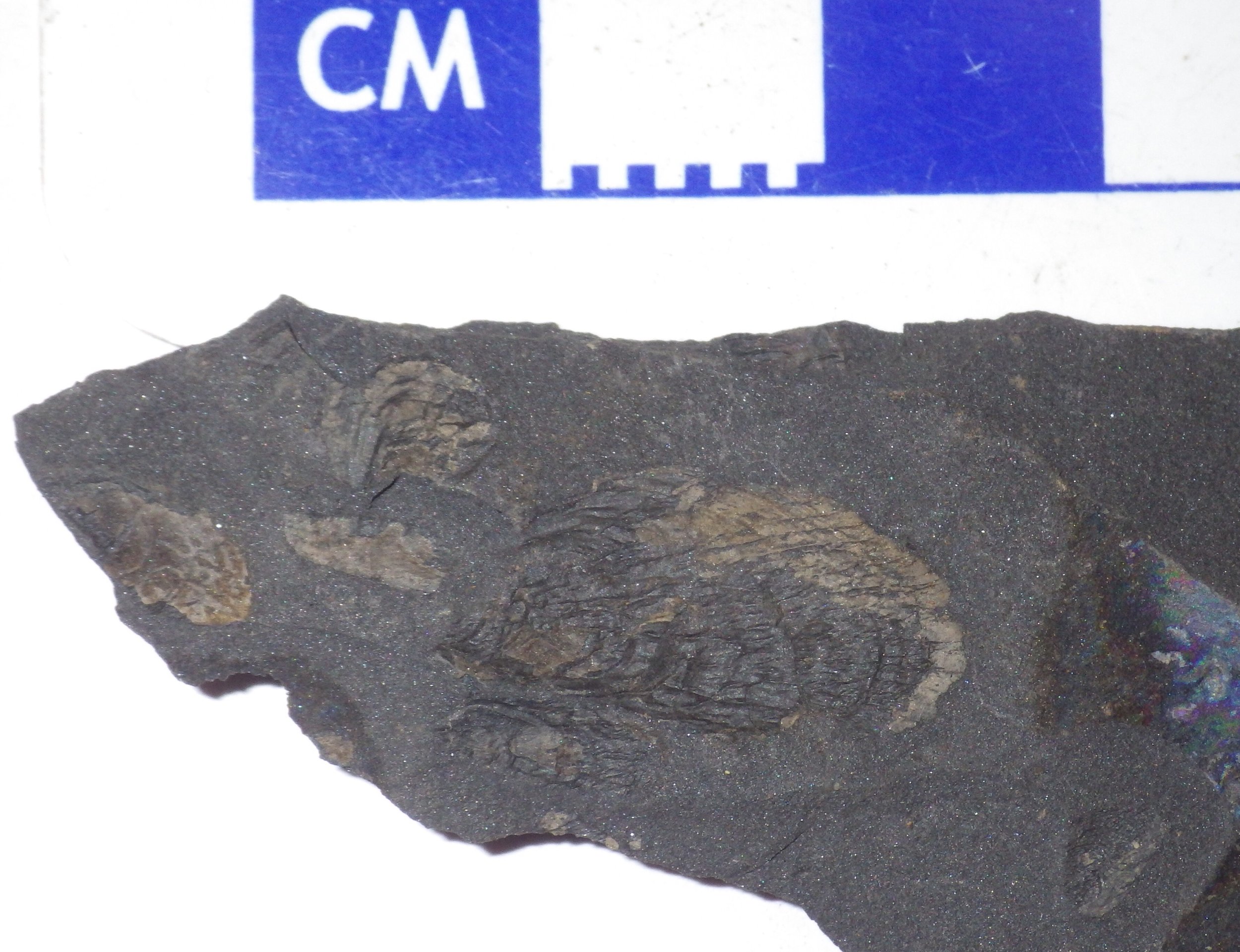 As Brett, Tim, and I headed back to Virginia after our fossil plant collecting trip to Beckley, West Virginia a couple of weeks ago, we made a second brief collecting stop in Princeton, WV. Several years ago, Tim and I stumbled onto a fossiliferous outcrop while fixing a flat tire of my field truck, so we revisited this site to collect some specimens for WSC.The outcrop exposes the Late Carboniferous Pride Shale Member of the Bluestone Formation, which seems to represent a shallow intertidal environment. It looks like all the fossils we collected are tiny pteroid mollusks, most of which are less than 2 mm long. We collected a few small pieces of shale (the outcrop is weathered, and the shale tends to fall apart), which contains perhaps 50-100 mollusk specimens. There is also a possibility that fossils of other organisms could turn up once we've had a chance to examine the rocks more carefully.
As Brett, Tim, and I headed back to Virginia after our fossil plant collecting trip to Beckley, West Virginia a couple of weeks ago, we made a second brief collecting stop in Princeton, WV. Several years ago, Tim and I stumbled onto a fossiliferous outcrop while fixing a flat tire of my field truck, so we revisited this site to collect some specimens for WSC.The outcrop exposes the Late Carboniferous Pride Shale Member of the Bluestone Formation, which seems to represent a shallow intertidal environment. It looks like all the fossils we collected are tiny pteroid mollusks, most of which are less than 2 mm long. We collected a few small pieces of shale (the outcrop is weathered, and the shale tends to fall apart), which contains perhaps 50-100 mollusk specimens. There is also a possibility that fossils of other organisms could turn up once we've had a chance to examine the rocks more carefully.
Fossil Friday - Carboniferous plants
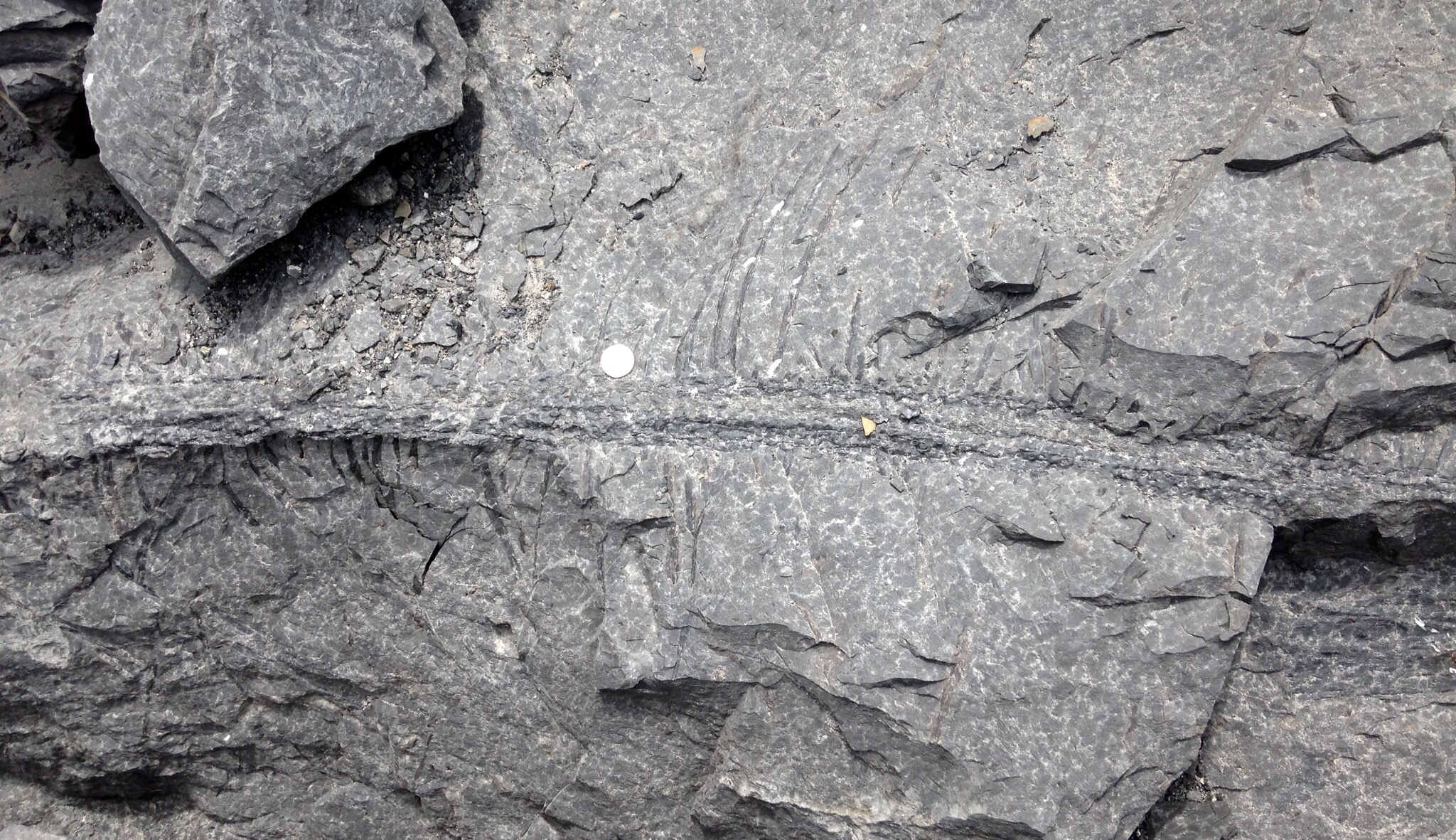 Last week I made a short trip back to Virginia for my son's graduation from Patrick Henry Community College. This also was a perfect opportunity for some fossil collecting, so Brett, Tim, and I met DorothyBelle Poli and Lisa Stoneman from Roanoke College for a day trip to Beckley, West Virginia.Boxley Materials operates a quarry near Beckley that cuts through the Carboniferous (~ 318 million-year-old) New River Formation. Certain beds of the New River Formation are full of fossil plants, and Boxley set aside some of this material for us to examine. Like many Carboniferous forests, one of the most prominent types of plants in these deposits is giant lycopods. Above is an example of Stigmaria, part of the root system of these lycopods (because it's rare to find all the parts of a plant in a single fossil, different fossil plant structures often have different scientific names). Unfortunately, this Stigmaria was in a rock that was far too large for us to collect.Giant lycopods are sometimes called "scale trees" because of the geometric (often diamond-shaped) leaf scars on their trunks:
Last week I made a short trip back to Virginia for my son's graduation from Patrick Henry Community College. This also was a perfect opportunity for some fossil collecting, so Brett, Tim, and I met DorothyBelle Poli and Lisa Stoneman from Roanoke College for a day trip to Beckley, West Virginia.Boxley Materials operates a quarry near Beckley that cuts through the Carboniferous (~ 318 million-year-old) New River Formation. Certain beds of the New River Formation are full of fossil plants, and Boxley set aside some of this material for us to examine. Like many Carboniferous forests, one of the most prominent types of plants in these deposits is giant lycopods. Above is an example of Stigmaria, part of the root system of these lycopods (because it's rare to find all the parts of a plant in a single fossil, different fossil plant structures often have different scientific names). Unfortunately, this Stigmaria was in a rock that was far too large for us to collect.Giant lycopods are sometimes called "scale trees" because of the geometric (often diamond-shaped) leaf scars on their trunks: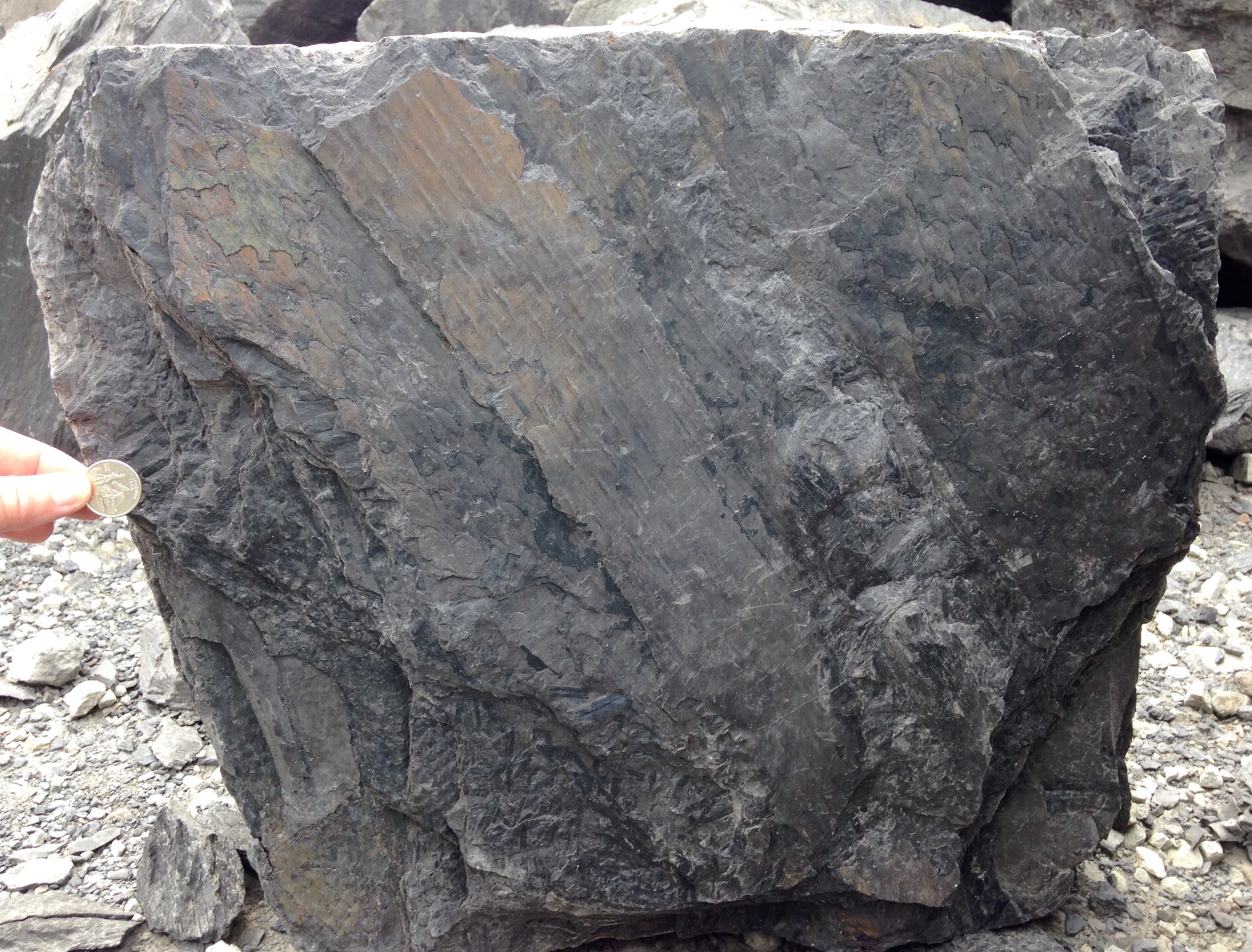 Seed ferns are also widespread in Carboniferous deposits; there are several different species in this sample:
Seed ferns are also widespread in Carboniferous deposits; there are several different species in this sample: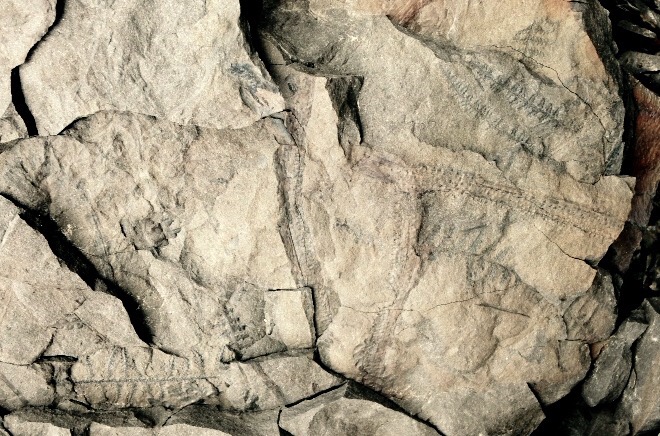 We are able to collect several good specimens for the Western Science Center, which will be nice additions to our growing paleobotany collection.
We are able to collect several good specimens for the Western Science Center, which will be nice additions to our growing paleobotany collection.
Fossil Friday - Bison atlas vertebra
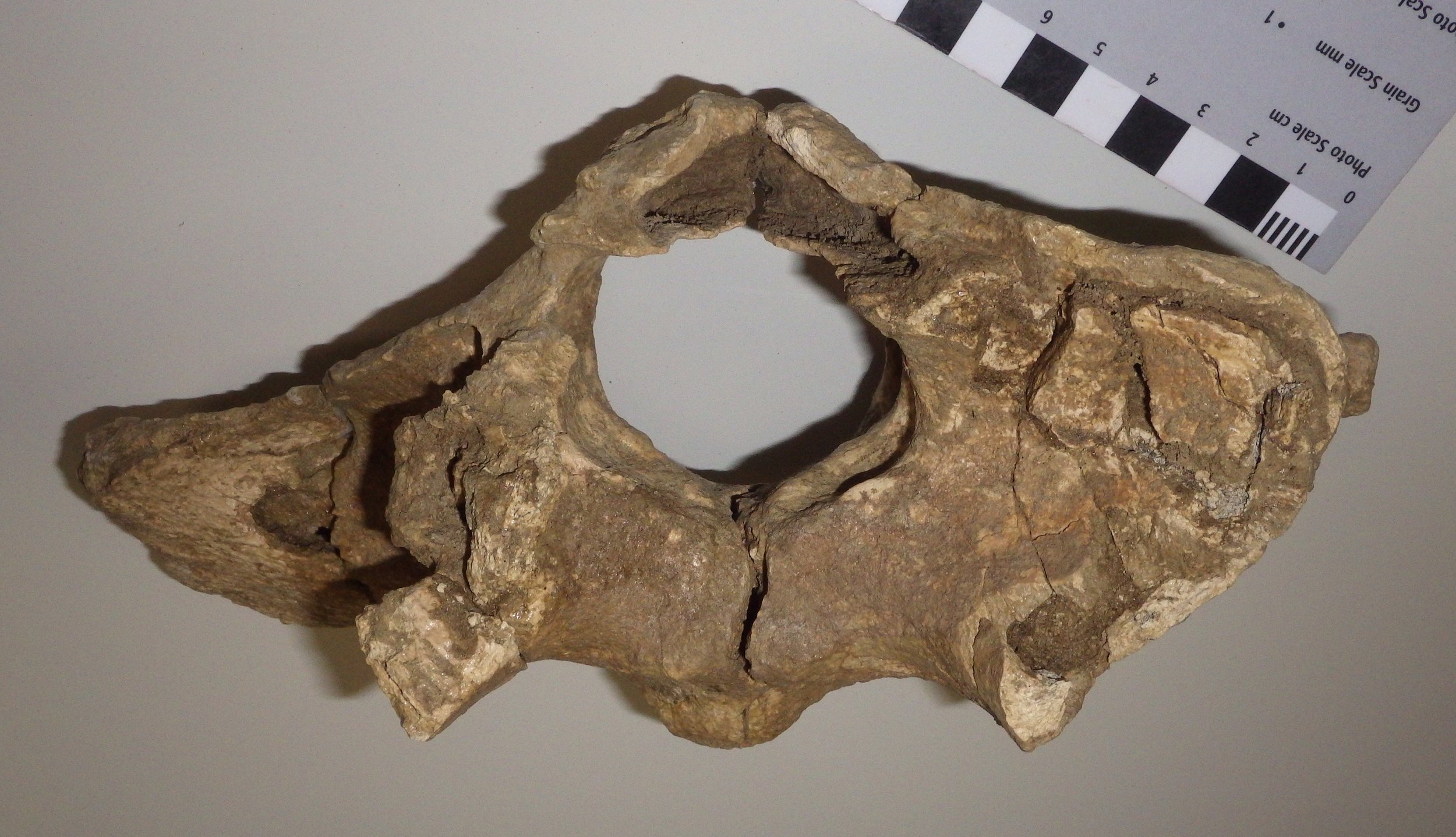 For this week's Fossil Friday I'm going to stick with bison, this time featuring an atlas vertebra.As I've described in earlier posts, the mammalian vertebral column is generally divided into five different regions. The most anterior are the cervical (neck) vertebrae. Almost all mammals have exactly seven cervical vertebrae, but mammals are unique among vertebrate classes in having such a tightly constrained cervical count. The first two cervical vertebrae, the atlas and the axis, are always highly specialized and look very different from any of the other vertebrae.That is mainly because of the complex articulations necessary to allow a range of movement in the head. When you nod your head (flexion and extension), that motion primarily occurs at the joint between the front of the atlas vertebra and the skull. When you shake your head (rotation) the motion is mostly at the joint between the back of the atlas vertebra and the front of the axis vertebra. That all means that the atlas has to accommodate one type of motion (nodding) on its front surface, a different motion (rotating) on its back surface, while providing attachment points for all the muscles that actually cause the movement, and allowing a passageway for the spinal cord and the vertebral arteries and veins through the middle of all of this movement. It's no wonder that the atlas has such a distinctive appearance. (As an interesting aside, whales, which have almost no ability to move their heads, still have complex and unique atlas and axis vertebrae, a relict of their ancestors that had much more mobile necks.)So, with all that said, the image at top shows a bison atlas vertebra in anterior (cranial) view. The bone is somewhat crushed and incomplete; much of the right side in particular is missing (remember, since this is anterior view, the right side of the vertebra is on the left side of the photo). The large hole in the bone is the neural canal, the passageway for the spinal cord. Below and beside the neural canal (centered at the "5-o'clock" and "7-o'clock" positions) are large depressions that articulate with the occipital condyles on the skull; this is the main "nodding" articulation.
For this week's Fossil Friday I'm going to stick with bison, this time featuring an atlas vertebra.As I've described in earlier posts, the mammalian vertebral column is generally divided into five different regions. The most anterior are the cervical (neck) vertebrae. Almost all mammals have exactly seven cervical vertebrae, but mammals are unique among vertebrate classes in having such a tightly constrained cervical count. The first two cervical vertebrae, the atlas and the axis, are always highly specialized and look very different from any of the other vertebrae.That is mainly because of the complex articulations necessary to allow a range of movement in the head. When you nod your head (flexion and extension), that motion primarily occurs at the joint between the front of the atlas vertebra and the skull. When you shake your head (rotation) the motion is mostly at the joint between the back of the atlas vertebra and the front of the axis vertebra. That all means that the atlas has to accommodate one type of motion (nodding) on its front surface, a different motion (rotating) on its back surface, while providing attachment points for all the muscles that actually cause the movement, and allowing a passageway for the spinal cord and the vertebral arteries and veins through the middle of all of this movement. It's no wonder that the atlas has such a distinctive appearance. (As an interesting aside, whales, which have almost no ability to move their heads, still have complex and unique atlas and axis vertebrae, a relict of their ancestors that had much more mobile necks.)So, with all that said, the image at top shows a bison atlas vertebra in anterior (cranial) view. The bone is somewhat crushed and incomplete; much of the right side in particular is missing (remember, since this is anterior view, the right side of the vertebra is on the left side of the photo). The large hole in the bone is the neural canal, the passageway for the spinal cord. Below and beside the neural canal (centered at the "5-o'clock" and "7-o'clock" positions) are large depressions that articulate with the occipital condyles on the skull; this is the main "nodding" articulation.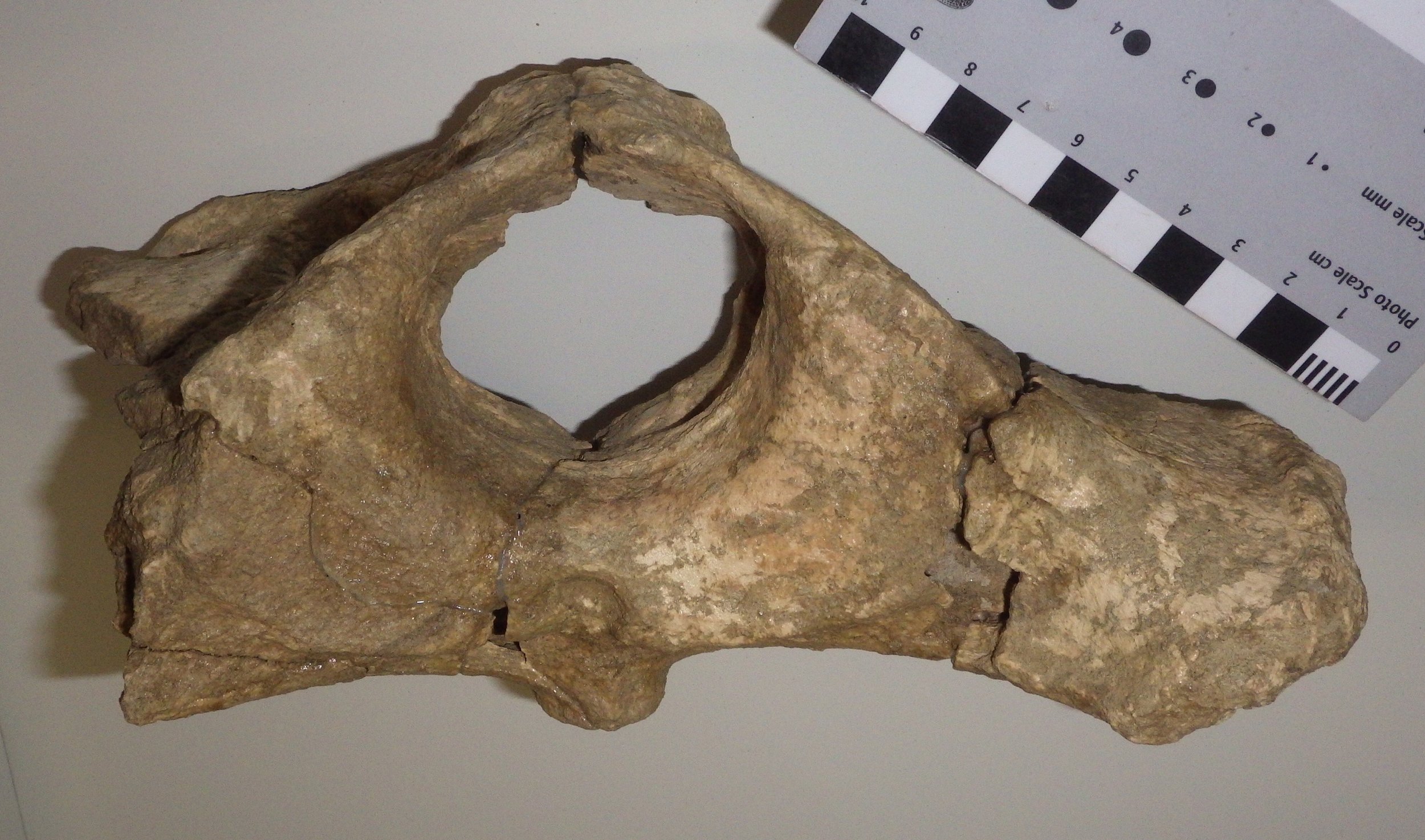 Looking at the same vertebra in posterior (caudal) view, we see broad, flat surfaces below and beside the neural canal. These are the articular surfaces for the axis vertebra, where rotation occurs. The large projection of bone on the right is a lateral or transverse process (the corresponding one on the left side is broken off). This provides a surface for the attachment of neck muscles associated with head movement. Bison have large, heavy heads, and so the muscle attachment areas to support them are relatively large.Here's the atlas in dorsal (top) view:
Looking at the same vertebra in posterior (caudal) view, we see broad, flat surfaces below and beside the neural canal. These are the articular surfaces for the axis vertebra, where rotation occurs. The large projection of bone on the right is a lateral or transverse process (the corresponding one on the left side is broken off). This provides a surface for the attachment of neck muscles associated with head movement. Bison have large, heavy heads, and so the muscle attachment areas to support them are relatively large.Here's the atlas in dorsal (top) view: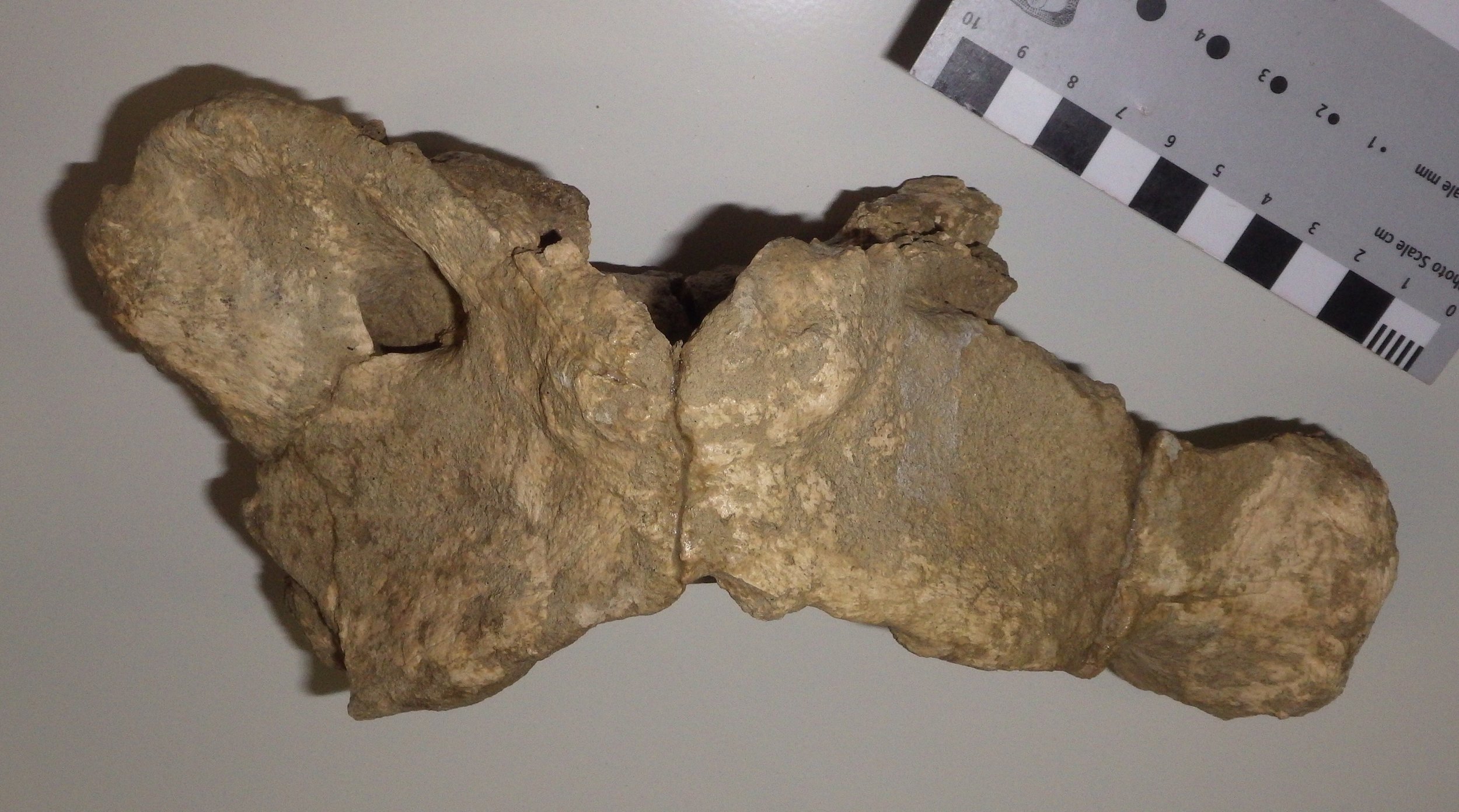 At this angle you can see that the transverse process is broad across the top surface, and has quite a large surface area. The opening toward the upper left is the alar foramen (the right one is only partially preserved), which provides a passageway for the vertebral arteries and veins.Even allowing for damage to the bone, the shape of this atlas seems a bit different from that of the modern Bison bison (see this site for an example). There are two different species of Bison known from the Diamond Valley Lake fauna, B. antiquus and B. latifrons. B. latifrons has a larger, heavier head than B. antiquus, and it's possible that this might be reflected in the anatomy of the cervical vertebrae, but I've not yet checked references to confirm this. At the moment, we have this particular atlas identified as Bison sp.
At this angle you can see that the transverse process is broad across the top surface, and has quite a large surface area. The opening toward the upper left is the alar foramen (the right one is only partially preserved), which provides a passageway for the vertebral arteries and veins.Even allowing for damage to the bone, the shape of this atlas seems a bit different from that of the modern Bison bison (see this site for an example). There are two different species of Bison known from the Diamond Valley Lake fauna, B. antiquus and B. latifrons. B. latifrons has a larger, heavier head than B. antiquus, and it's possible that this might be reflected in the anatomy of the cervical vertebrae, but I've not yet checked references to confirm this. At the moment, we have this particular atlas identified as Bison sp.
Fossil Friday - "Then the rats got him"
 Bison are among the most common large animals in the Pleistocene Diamond Valley Lake fauna, but like almost all the remains from these deposits they are usually fragmentary. But even fragmentary fossils can provide a lot of information, including the bison right lower jaw fragment shown here.Sometimes bonebeds or other rich deposits of fossils are formed during catastrophic events, with large numbers of organisms buried together very rapidly. That's not what we see in Diamond and Domenigoni Valleys, however; these deposits are primarily the result of the gradual accumulation of skeletons over thousands of years. That means that an individual skeleton may have laid exposed at the surface for a significant period of time before it was eventually buried. This exposes the bones to sun, wind, and rain, all of which can cause the bone to deteriorate and the skeleton to fall apart, and to scavengers, which may damage or eat the bones, or carry pieces away. All these things contribute to the fragmentary nature of the Diamond Valley Lake specimens.Evidence of the specific types postmortem trauma experienced by these bones is sometimes preserved. If we zoom in on the bison jaw shown above, we can see a series of grooves cut into the bone:
Bison are among the most common large animals in the Pleistocene Diamond Valley Lake fauna, but like almost all the remains from these deposits they are usually fragmentary. But even fragmentary fossils can provide a lot of information, including the bison right lower jaw fragment shown here.Sometimes bonebeds or other rich deposits of fossils are formed during catastrophic events, with large numbers of organisms buried together very rapidly. That's not what we see in Diamond and Domenigoni Valleys, however; these deposits are primarily the result of the gradual accumulation of skeletons over thousands of years. That means that an individual skeleton may have laid exposed at the surface for a significant period of time before it was eventually buried. This exposes the bones to sun, wind, and rain, all of which can cause the bone to deteriorate and the skeleton to fall apart, and to scavengers, which may damage or eat the bones, or carry pieces away. All these things contribute to the fragmentary nature of the Diamond Valley Lake specimens.Evidence of the specific types postmortem trauma experienced by these bones is sometimes preserved. If we zoom in on the bison jaw shown above, we can see a series of grooves cut into the bone: These grooves are bite marks, most likely made by rodents. Bone gnawing has been documented in lots of different rodents, including rats, mice, and squirrels. It's generally attributed to the need for rodents to keep their ever-growing incisors from becoming too long, and perhaps to provide an additional source of calcium. But the presence of these marks immediately tells us quite a bit of additional information; the bison died in a setting that didn't result in immediate burial, and rodents were present in the environment.Of course, from the bison's point of view, maybe this is only adding insult to injury!
These grooves are bite marks, most likely made by rodents. Bone gnawing has been documented in lots of different rodents, including rats, mice, and squirrels. It's generally attributed to the need for rodents to keep their ever-growing incisors from becoming too long, and perhaps to provide an additional source of calcium. But the presence of these marks immediately tells us quite a bit of additional information; the bison died in a setting that didn't result in immediate burial, and rodents were present in the environment.Of course, from the bison's point of view, maybe this is only adding insult to injury!
Fossil Friday - western pond turtle costal plate
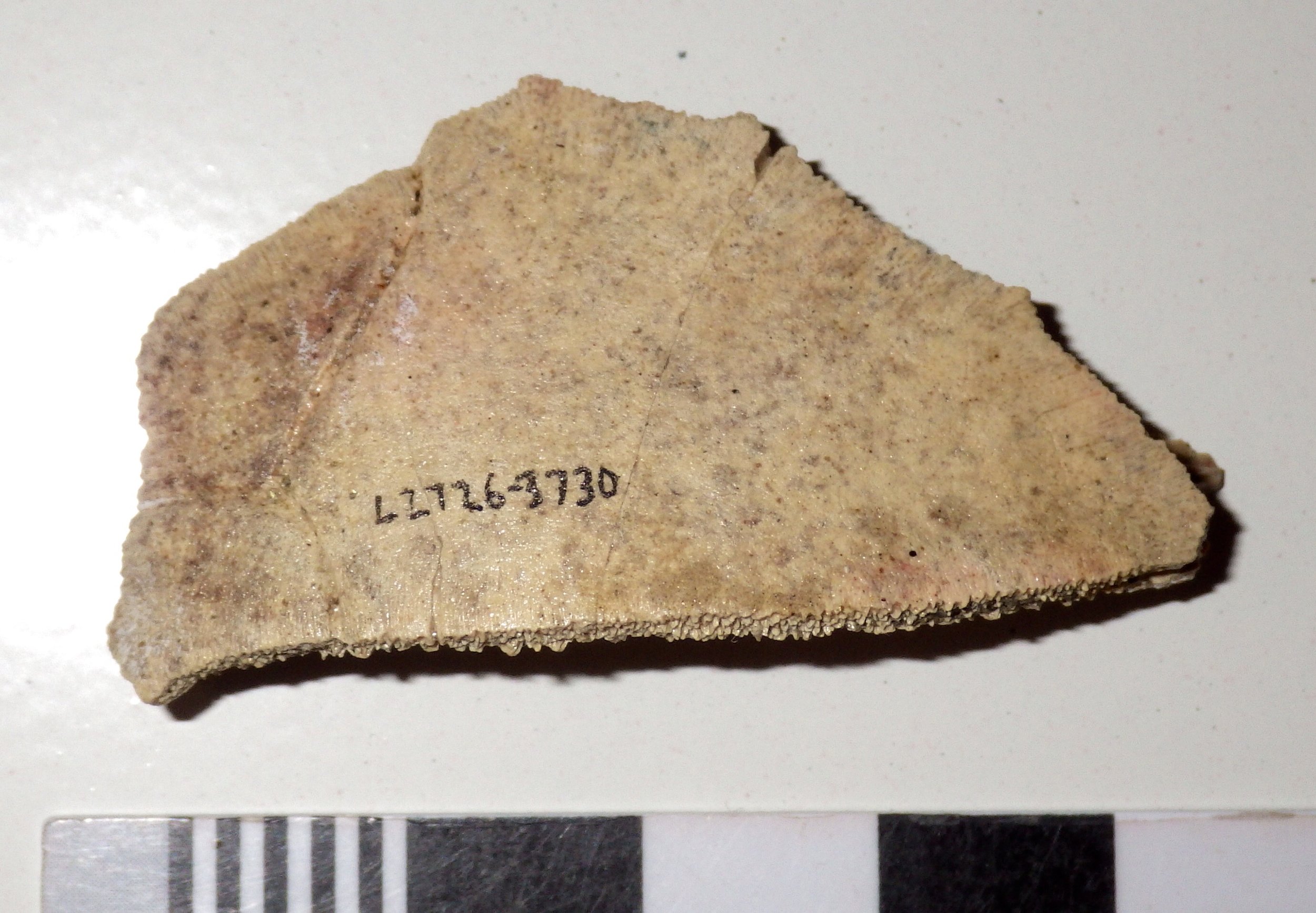 Fossil preservation is a tricky thing, and the variables involved in fossilization can have a major effect on what eventually gets preserved (a major subfield of paleontology, taphonomy, looks at this very issue). For vertebrates, one factor that can give you a high preservation potential is having a lot of bones, so that a large percentage of your body mass is more likely to survive. With their extensive bony shells, turtles should be a prime candidate for fossilization, and sure enough, large numbers were found in the Pleistocene Diamond Valley Lake fauna. Of course, having lots of bones is no guarantee that they'll survive in one piece; most of our turtle remains are fragments of the shell, and we have nothing even remotely approaching a complete turtle skeleton.Turtle shells have two main pieces, the carapace on the turtle's dorsal side and the plastron on the ventral side. The carapace and plastron, in turn, are each made up of numerous smaller bones. The piece shown above is from the carapace, technically called the first right costal, which formed the front right part of the shell. It's shown here in dorsal view; if the skeleton were complete, the turtle's skull would have been out of the image at the upper left. Here's a ventral view of the same bone (since this is from the carapace, it's like you're inside the turtle looking out):
Fossil preservation is a tricky thing, and the variables involved in fossilization can have a major effect on what eventually gets preserved (a major subfield of paleontology, taphonomy, looks at this very issue). For vertebrates, one factor that can give you a high preservation potential is having a lot of bones, so that a large percentage of your body mass is more likely to survive. With their extensive bony shells, turtles should be a prime candidate for fossilization, and sure enough, large numbers were found in the Pleistocene Diamond Valley Lake fauna. Of course, having lots of bones is no guarantee that they'll survive in one piece; most of our turtle remains are fragments of the shell, and we have nothing even remotely approaching a complete turtle skeleton.Turtle shells have two main pieces, the carapace on the turtle's dorsal side and the plastron on the ventral side. The carapace and plastron, in turn, are each made up of numerous smaller bones. The piece shown above is from the carapace, technically called the first right costal, which formed the front right part of the shell. It's shown here in dorsal view; if the skeleton were complete, the turtle's skull would have been out of the image at the upper left. Here's a ventral view of the same bone (since this is from the carapace, it's like you're inside the turtle looking out):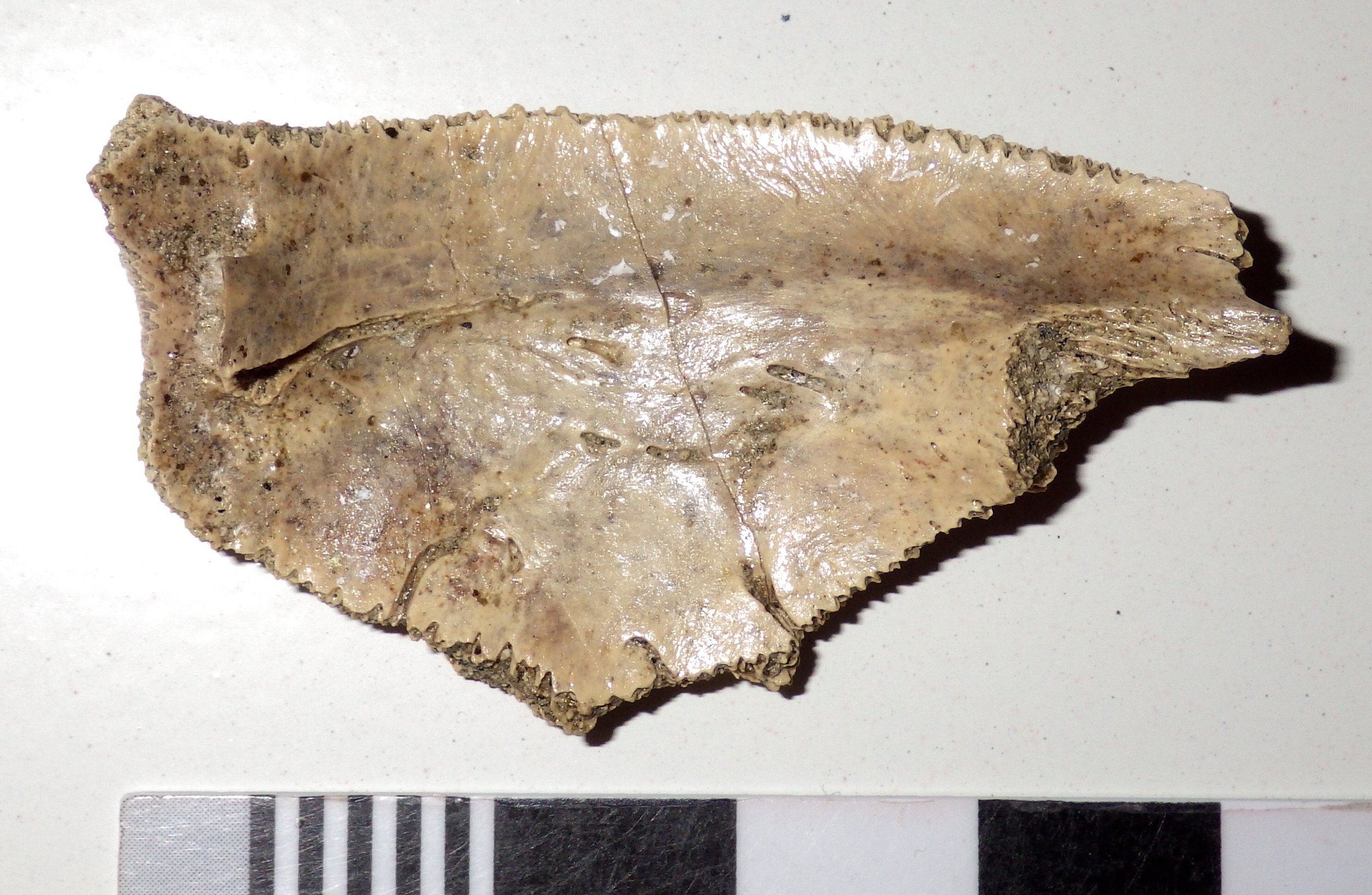 Most vertebrates that have bony armor (armadillos or crocodiles, for example) make their armor from dermal bones. These are bones that are embedded in the skin and generally have no direct connection to the rest of the skeleton. Many of the bones in a turtle's carapace are different in that they are attached directly to internal bones. The costal plates are attached to the ribs; this is more obvious in an oblique view of the ventral side of the bone, where the rib is clearly visible:
Most vertebrates that have bony armor (armadillos or crocodiles, for example) make their armor from dermal bones. These are bones that are embedded in the skin and generally have no direct connection to the rest of the skeleton. Many of the bones in a turtle's carapace are different in that they are attached directly to internal bones. The costal plates are attached to the ribs; this is more obvious in an oblique view of the ventral side of the bone, where the rib is clearly visible: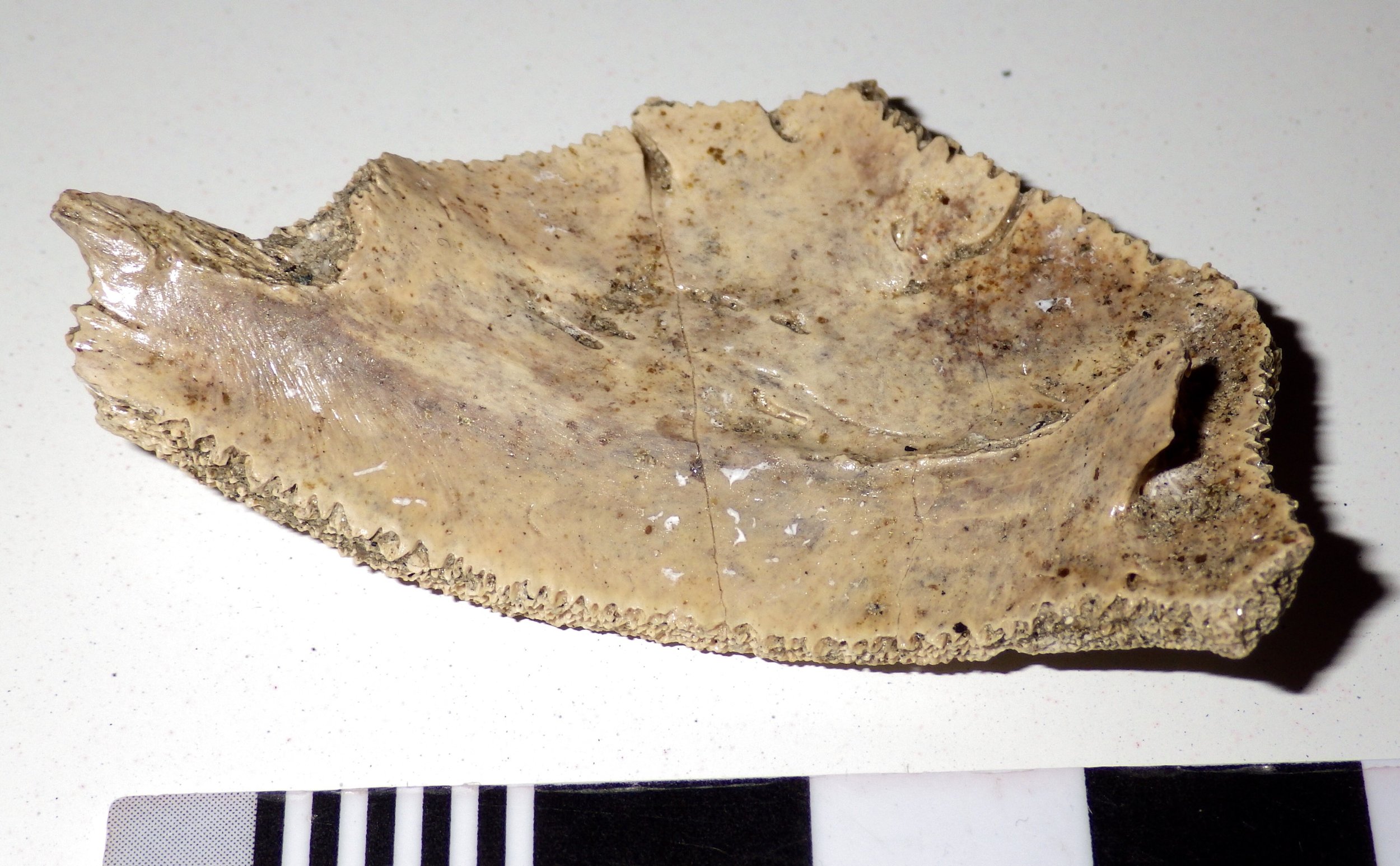 This particular costal bone is from a western pond turtle, Actinemys marmorota. These turtles are still found on the west coast, yet somehow I've never photographed one, even though I have dozens of turtle photos including every other genus in the family Emydidae. The closest relatives I've photographed are Blanding's turtle (Emydoidea blandingii) from the upper Midwest:
This particular costal bone is from a western pond turtle, Actinemys marmorota. These turtles are still found on the west coast, yet somehow I've never photographed one, even though I have dozens of turtle photos including every other genus in the family Emydidae. The closest relatives I've photographed are Blanding's turtle (Emydoidea blandingii) from the upper Midwest: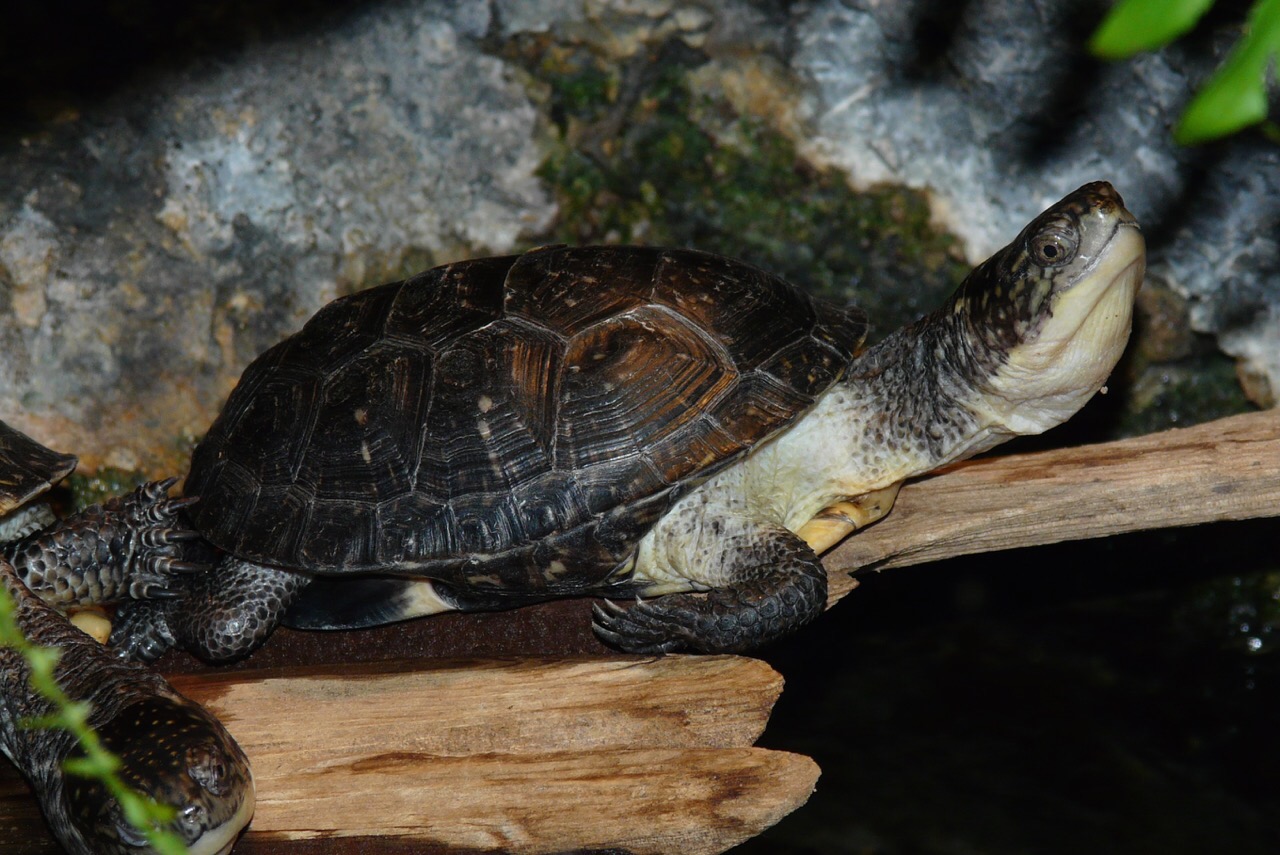 ...and the spotted turtle (Clemmys guttata) from the east coast:
...and the spotted turtle (Clemmys guttata) from the east coast: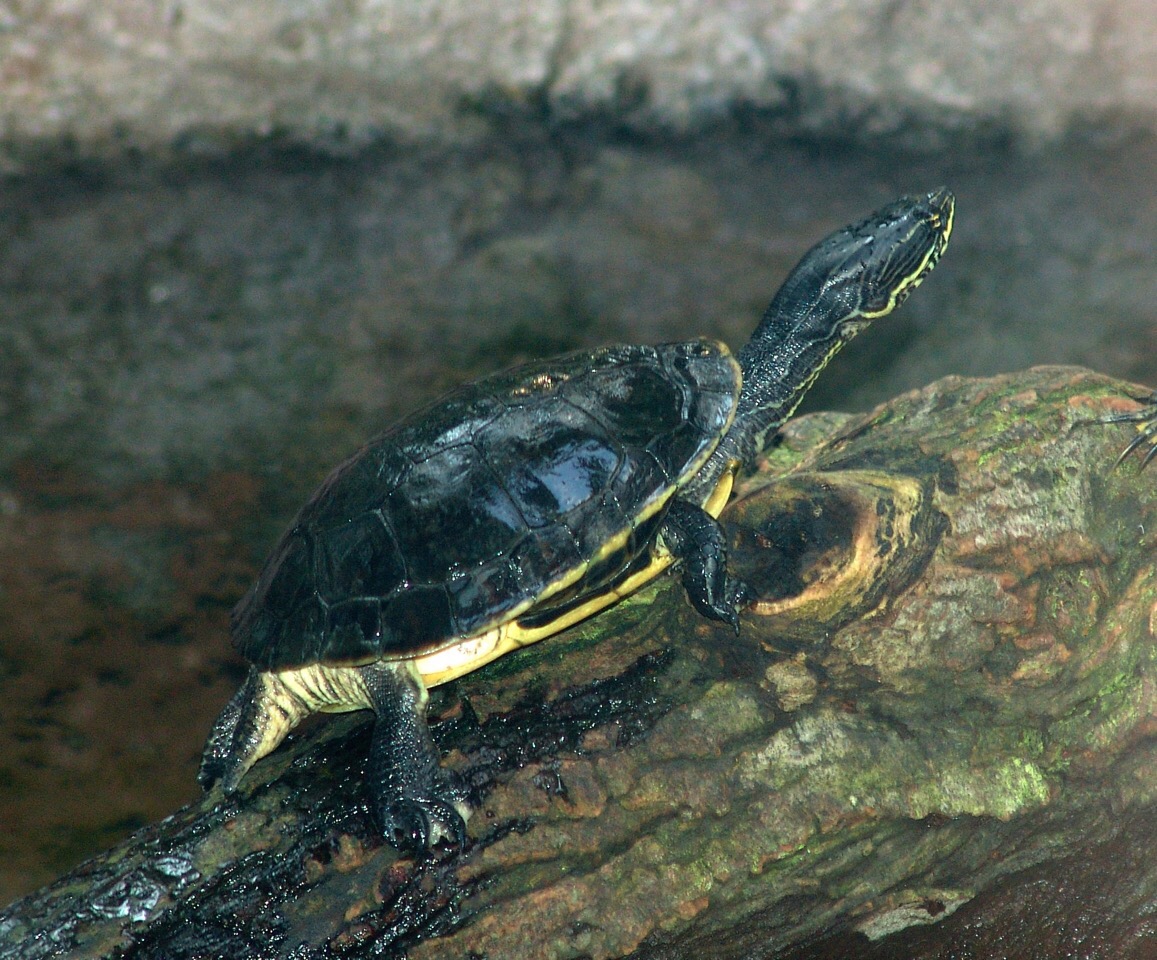 These three species are all closely related, and are in the same subfamily. In fact, until a few years ago Actinemys marmorota was placed in the genus Clemmys (our labels at WSC actually list these specimens as Clemmys marmorota); some workers have also proposed that Actimemys and Emydoidea in the same genus, Emys.
These three species are all closely related, and are in the same subfamily. In fact, until a few years ago Actinemys marmorota was placed in the genus Clemmys (our labels at WSC actually list these specimens as Clemmys marmorota); some workers have also proposed that Actimemys and Emydoidea in the same genus, Emys.
Fossil Friday - Harlan's ground sloth femur
 There are three different species of ground sloths known from the Pleistocene Diamond Valley Lake fauna. By far the most common of the three is Harlan's ground sloth, Paramylodon harlani. For this week's Fossil Friday we have a Paramylodon femur.This is the right femur, seen from the back (posterior view), with the distal end on the right. The articular surfaces for the knee joint are visible on the right, but the proximal end of the bone is not preserved so the ball joint where the femur attaches to the pelvis is missing (it would have been at the lower left corner of this image). Even though the bone is crushed, it has maintained its shape pretty well. Like many of the larger bones in the WSC collection, this one has only been prepared on one side.I've always found sloth femora fascinating, because they have a really strange shape when compared to most of the other mammals we find in Pleistocene deposits in North America. They appear to be very wide for their length, and generally kind of overbuilt for their size. To get an idea, compare this femur to the juvenile mastodon femur I wrote about a few months ago. These animals were probably roughly the same size, but the difference in their femoral proportions is striking.———On another note, we are busily preparing for tomorrow's Inland Empire Science Festival. If you're in Southern California we hope you can make it out to the Western Science Center tomorrow for this exciting event.
There are three different species of ground sloths known from the Pleistocene Diamond Valley Lake fauna. By far the most common of the three is Harlan's ground sloth, Paramylodon harlani. For this week's Fossil Friday we have a Paramylodon femur.This is the right femur, seen from the back (posterior view), with the distal end on the right. The articular surfaces for the knee joint are visible on the right, but the proximal end of the bone is not preserved so the ball joint where the femur attaches to the pelvis is missing (it would have been at the lower left corner of this image). Even though the bone is crushed, it has maintained its shape pretty well. Like many of the larger bones in the WSC collection, this one has only been prepared on one side.I've always found sloth femora fascinating, because they have a really strange shape when compared to most of the other mammals we find in Pleistocene deposits in North America. They appear to be very wide for their length, and generally kind of overbuilt for their size. To get an idea, compare this femur to the juvenile mastodon femur I wrote about a few months ago. These animals were probably roughly the same size, but the difference in their femoral proportions is striking.———On another note, we are busily preparing for tomorrow's Inland Empire Science Festival. If you're in Southern California we hope you can make it out to the Western Science Center tomorrow for this exciting event.
Fossil Friday - iguanid humerus
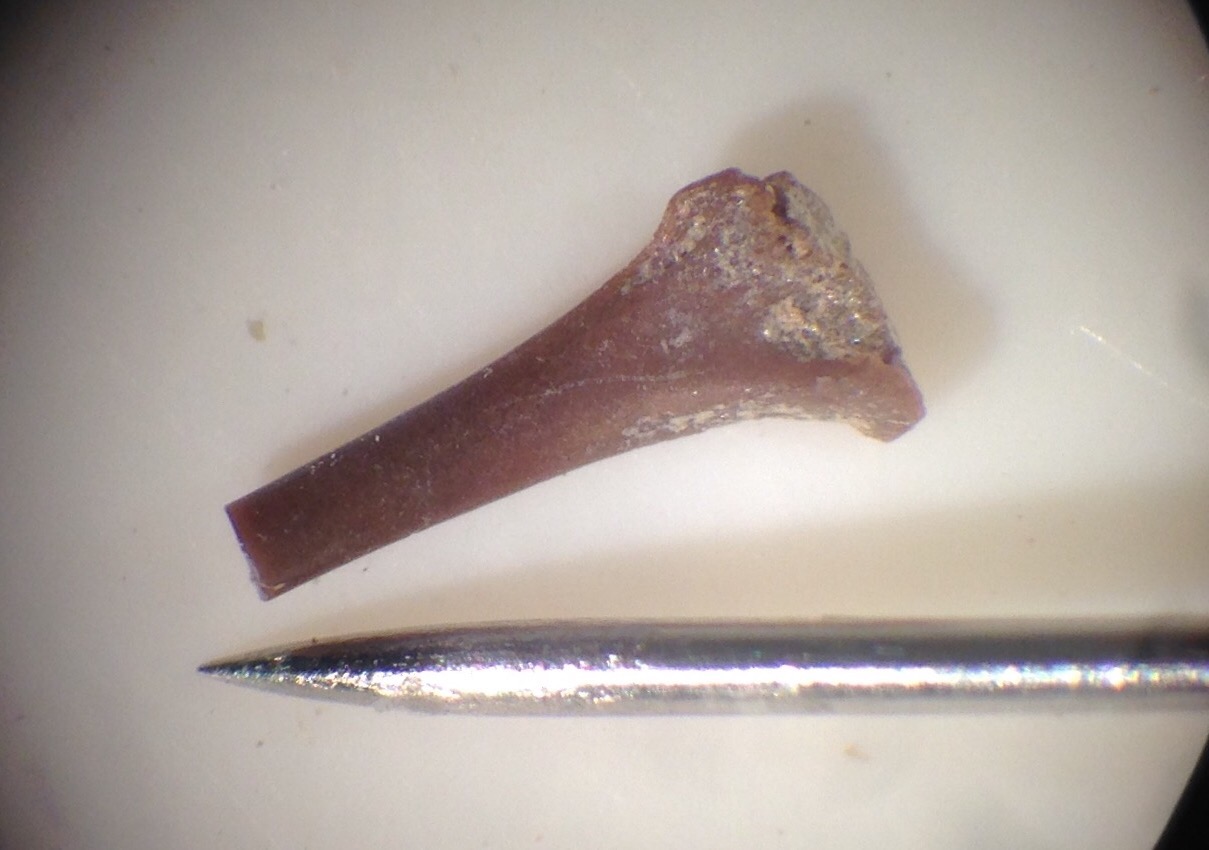 In terms of numbers, most of the Pleistocene fossils from Diamond Valley Lake are from small animals, especially rodents and other small mammals. But there are non-mammals represented as well, such as the rattlesnake I posted a few weeks ago, and today's example, a lizard.This specimen is the proximal part of the left humerus, the upper arm bone. It has been identified as coming from the Family Iguanidae. The most famous iguanid is Iguana itself, but the family is fairly diverse with a number of different genera. Two species still live in Southern California, the desert iguana Dipsosaurus dorsalis:
In terms of numbers, most of the Pleistocene fossils from Diamond Valley Lake are from small animals, especially rodents and other small mammals. But there are non-mammals represented as well, such as the rattlesnake I posted a few weeks ago, and today's example, a lizard.This specimen is the proximal part of the left humerus, the upper arm bone. It has been identified as coming from the Family Iguanidae. The most famous iguanid is Iguana itself, but the family is fairly diverse with a number of different genera. Two species still live in Southern California, the desert iguana Dipsosaurus dorsalis: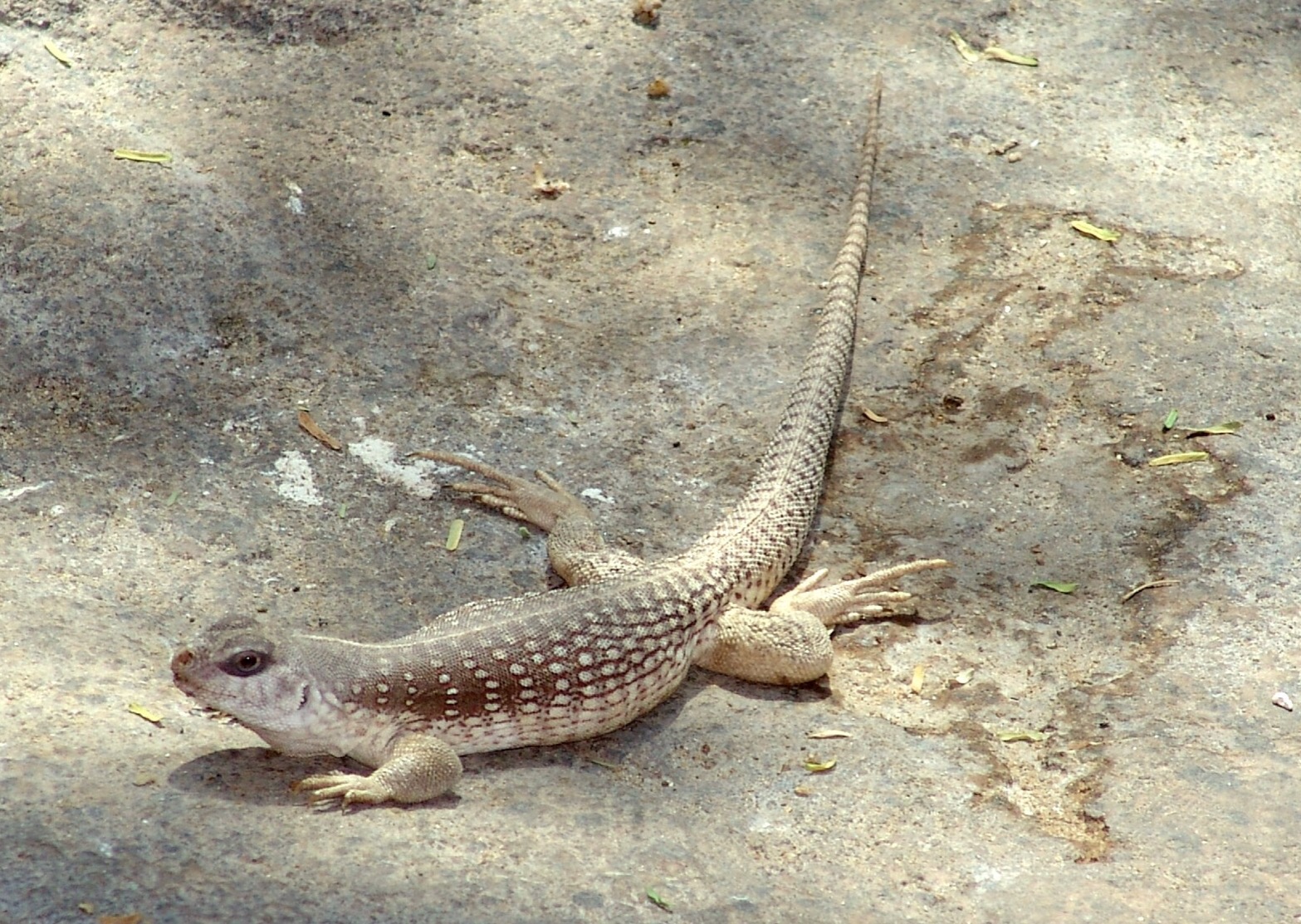 ... and the common chuckwalla Sauromalus ater:
... and the common chuckwalla Sauromalus ater: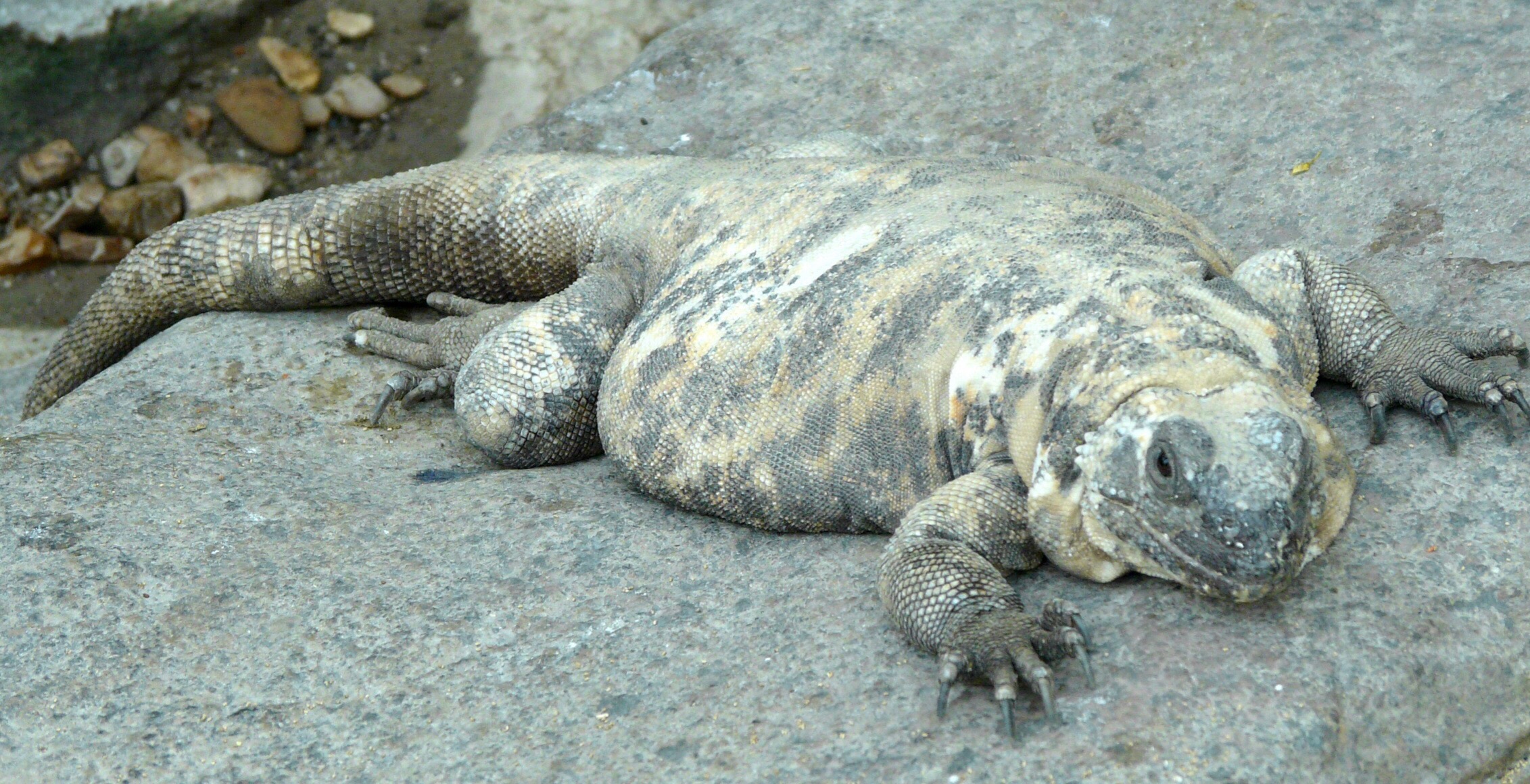 There is also an extinct iguana from Riverside County, Pumila novaceki, that has been found in somewhat older sediments than those found at Diamond Valley Lake. This humerus could have come from any of these small iguanids.
There is also an extinct iguana from Riverside County, Pumila novaceki, that has been found in somewhat older sediments than those found at Diamond Valley Lake. This humerus could have come from any of these small iguanids.
Fossil Friday - bite marks on a camel skull
 One of the specimens we have on display at the Western Science Center is a cranium and partial vertebral column including the neck of the camel Camelops hesternus. A closer examination of the skull reveals some surprising features. The parietals (the bones that make up the back half of the top of the braincase) have a series of holes and apparent scrapes:
One of the specimens we have on display at the Western Science Center is a cranium and partial vertebral column including the neck of the camel Camelops hesternus. A closer examination of the skull reveals some surprising features. The parietals (the bones that make up the back half of the top of the braincase) have a series of holes and apparent scrapes: At first I thought the two back holes might be an anatomical feature called the parietal foramen. However, parietal foramina are uncommon, usually forming as a developmental abnormality. I've been unable to find images or reports of parietal foramina in Camelops or any other camel. The holes in this specimen are not symmetrical in their position (each one is located in a different position on its respective parietal), and there are cracks in the parietals leading to the holes. Finally, if these were parietal foramina, it doesn't help to explain the presence of the other hole located at the front of the parietal. Taken together, this suggests that the holes are not an anatomical feature but instead are bite marks from another animal.I originally envisioned a carnivore grabbing the camel by the top of the head, with its head held almost parallel to the camel's head, and then dragging the camel's head and neck away from the rest of the carcass. This would mean that the four parietal marks (three punctures and one scrape) were made by the four canines of the carnivore in a single bite. Darla and I pulled out cast skulls of several different carnivores to try this out, but we couldn't get it to work. If we assume that the four marks were made in a single bite, then the spacing is about right for a small dire wolf, a black bear, or a jaguar. However, when we tried to simulate the bite the predator's incisors would always hit the sagittal crest (the ridge of bone along the top of the skull) long before the canines reached the parietals. If we went with larger animals with longer canines like a short-faced bear or an American lion, the canines would reach the parietals but the spacing was far to close for such a large animal.I now think that it's more likely that the punctures were caused by multiple bites, by a carnivore coming at the skull from an oblique angle (possibly multiple angles), something like this:
At first I thought the two back holes might be an anatomical feature called the parietal foramen. However, parietal foramina are uncommon, usually forming as a developmental abnormality. I've been unable to find images or reports of parietal foramina in Camelops or any other camel. The holes in this specimen are not symmetrical in their position (each one is located in a different position on its respective parietal), and there are cracks in the parietals leading to the holes. Finally, if these were parietal foramina, it doesn't help to explain the presence of the other hole located at the front of the parietal. Taken together, this suggests that the holes are not an anatomical feature but instead are bite marks from another animal.I originally envisioned a carnivore grabbing the camel by the top of the head, with its head held almost parallel to the camel's head, and then dragging the camel's head and neck away from the rest of the carcass. This would mean that the four parietal marks (three punctures and one scrape) were made by the four canines of the carnivore in a single bite. Darla and I pulled out cast skulls of several different carnivores to try this out, but we couldn't get it to work. If we assume that the four marks were made in a single bite, then the spacing is about right for a small dire wolf, a black bear, or a jaguar. However, when we tried to simulate the bite the predator's incisors would always hit the sagittal crest (the ridge of bone along the top of the skull) long before the canines reached the parietals. If we went with larger animals with longer canines like a short-faced bear or an American lion, the canines would reach the parietals but the spacing was far to close for such a large animal.I now think that it's more likely that the punctures were caused by multiple bites, by a carnivore coming at the skull from an oblique angle (possibly multiple angles), something like this: This actually may be more consistent with the behavior of modern carnivores; if you want gory confirmation, do an image search for "hyena carrying head" for examples of how scavenging carnivores transport prey. There is also some evidence that there may be additional bite marks all over this skull, consistent with multiple bites. There are two unusual depressions in the top of the frontal bone, several holes along the edge of the right lambdoidal crest at the back of the skull, and damage to part of the right squamosal. To be fair, none of these additional marks are sure things; if not for the four bite marks on the parietal I would have never considered these as likely candidates for bite marks.Another observation I would not have thought twice about except for this context is the damage at the front of the skull. The nasal bones are damaged, and the premaxillary bones are missing entirely. The premaxillae can loosen and fall off as a skull dries out, and that's normally how I would explain this. But if this skull was being chewed up by carnivores it raises another possibility. It seems that the nose is one of the choice bits of meat on the skull for a carnivore. There's a lot of meat and blood in the nose, and it's easier to get to than the brain. Moreover, while cats such as lions usually kill their prey with a bite to the neck, closing the windpipe, an alternate method used on occasion is to bite down on the nose. Is it possible that the missing premaxillae in this specimen is another predation feature?
This actually may be more consistent with the behavior of modern carnivores; if you want gory confirmation, do an image search for "hyena carrying head" for examples of how scavenging carnivores transport prey. There is also some evidence that there may be additional bite marks all over this skull, consistent with multiple bites. There are two unusual depressions in the top of the frontal bone, several holes along the edge of the right lambdoidal crest at the back of the skull, and damage to part of the right squamosal. To be fair, none of these additional marks are sure things; if not for the four bite marks on the parietal I would have never considered these as likely candidates for bite marks.Another observation I would not have thought twice about except for this context is the damage at the front of the skull. The nasal bones are damaged, and the premaxillary bones are missing entirely. The premaxillae can loosen and fall off as a skull dries out, and that's normally how I would explain this. But if this skull was being chewed up by carnivores it raises another possibility. It seems that the nose is one of the choice bits of meat on the skull for a carnivore. There's a lot of meat and blood in the nose, and it's easier to get to than the brain. Moreover, while cats such as lions usually kill their prey with a bite to the neck, closing the windpipe, an alternate method used on occasion is to bite down on the nose. Is it possible that the missing premaxillae in this specimen is another predation feature?
Fossil Friday - Carboniferous plant donation
 During my trip to the Midwest last month I made a brief stop at Earlham College in Indiana, where I have a lot of longtime friends and where I've done some work in the past with their excellent campus museum, the Joseph Moore Museum. While at Earlham I picked up a collection of fossil plants that were donated to the Western Science Center by the Earlham Geology Department.
During my trip to the Midwest last month I made a brief stop at Earlham College in Indiana, where I have a lot of longtime friends and where I've done some work in the past with their excellent campus museum, the Joseph Moore Museum. While at Earlham I picked up a collection of fossil plants that were donated to the Western Science Center by the Earlham Geology Department.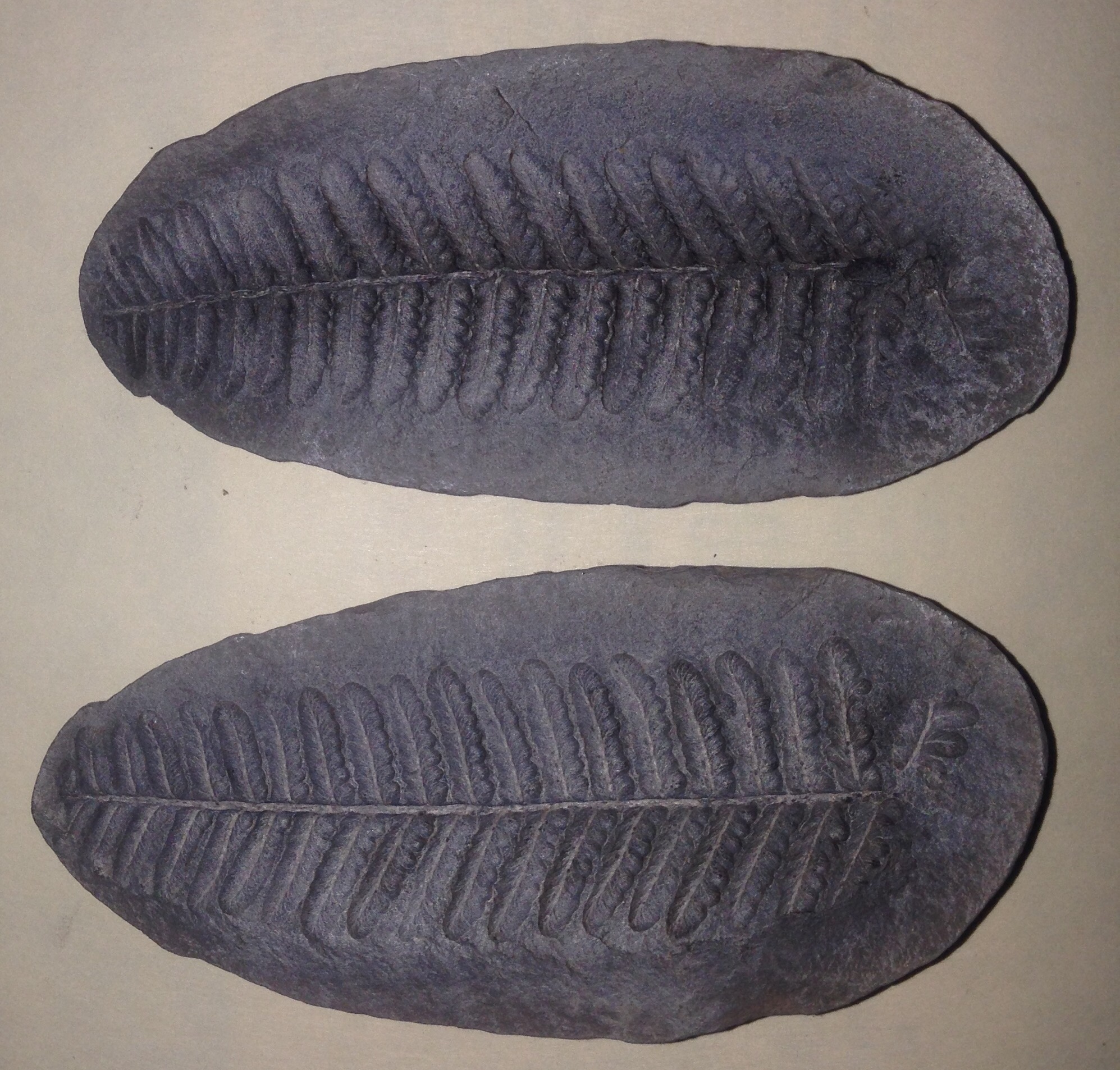 The majority of these plants are from a world famous locality in Illinois called Mazon Creek, which includes sediments from the Late Carboniferous Period (approximately 300 million years old). Through a combination of rapid burial and unusual geochemical conditions organic material at Mazon Creek was exquisitely preserved in hard concretions. The vast majority of the Mazon Creek fossils are plants (and the collections donated to WSC only includes plants) but many animals have also been recovered, including marine invertebrates (even soft-bodied jellyfish), insects and other terrestrial invertebrates, and occasional fish and sharks.It will take us awhile to sort and identify all the specimens in the donation, which included several boxes of material. The WSC previously had almost no Carboniferous fossils in our collection, so this is a very nice addition. I'd like to thank Andrew Moore and Cynthia Fadem of the Earlham College Geology Department for arranging for the donation of this wonderful collection.
The majority of these plants are from a world famous locality in Illinois called Mazon Creek, which includes sediments from the Late Carboniferous Period (approximately 300 million years old). Through a combination of rapid burial and unusual geochemical conditions organic material at Mazon Creek was exquisitely preserved in hard concretions. The vast majority of the Mazon Creek fossils are plants (and the collections donated to WSC only includes plants) but many animals have also been recovered, including marine invertebrates (even soft-bodied jellyfish), insects and other terrestrial invertebrates, and occasional fish and sharks.It will take us awhile to sort and identify all the specimens in the donation, which included several boxes of material. The WSC previously had almost no Carboniferous fossils in our collection, so this is a very nice addition. I'd like to thank Andrew Moore and Cynthia Fadem of the Earlham College Geology Department for arranging for the donation of this wonderful collection.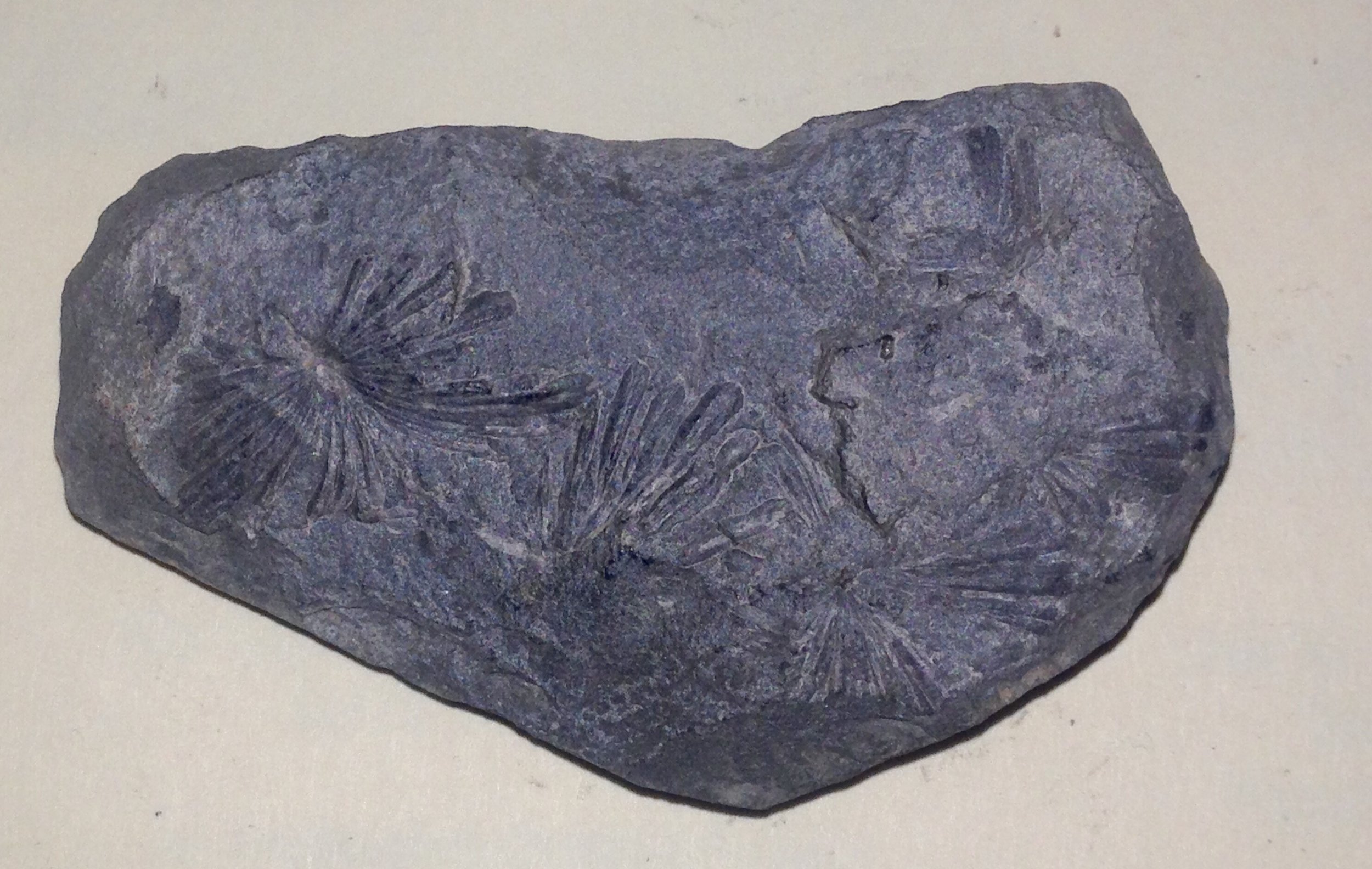
Fossil Friday - rattlesnake vertebra
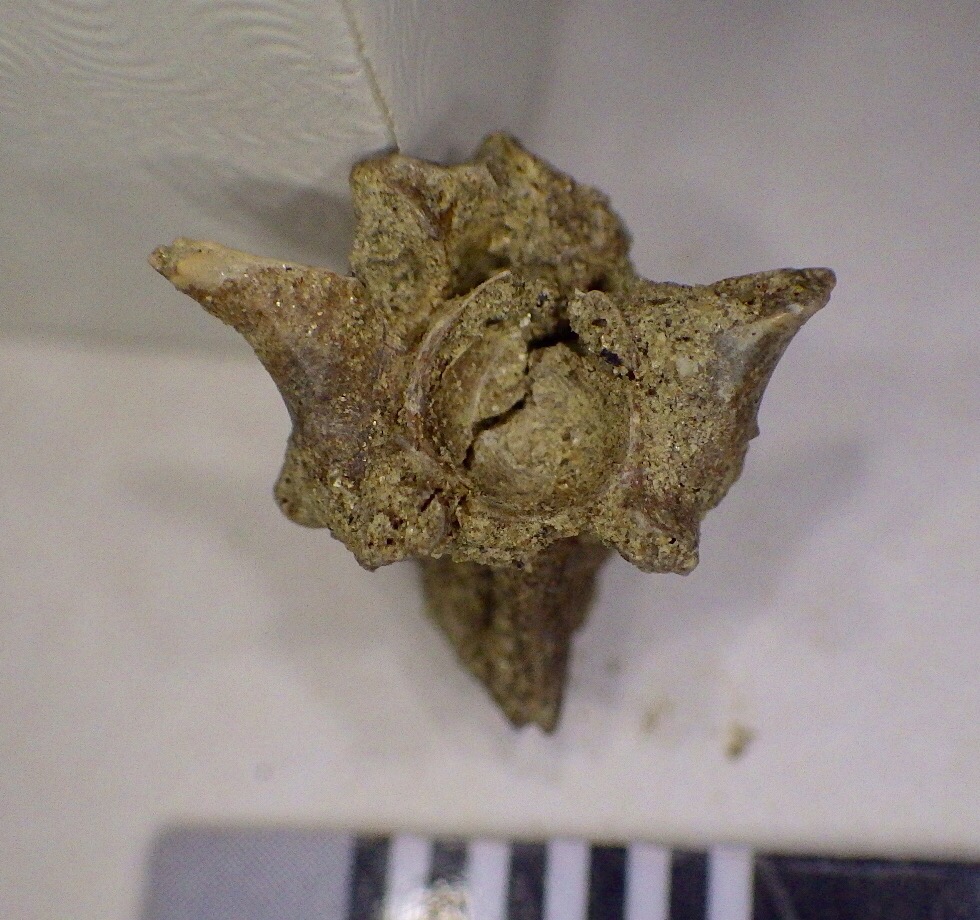 It's springtime, and in the Inland Empire that means snakes! The Pleistocene fossils from Southern California make it clear that this has been the case for a long time, as demonstrated by the vertebra shown above.This partial vertebra is probably from the genus Crotalus, a rattlesnake, shownfrom the front (anterior view). Snake vertebrae are procoelous, meaning that the vertebrae articulate with each other with a ball-and-socket joint with the socket on the front of the vertebra; the socket is clearly visible in the image above.Snakes have a lot of vertebrae, up to several hundred in some species, so each individual vertebra is typically not very big. This vertebra is a little over a centimeter across, which represents a pretty large rattlesnake.
It's springtime, and in the Inland Empire that means snakes! The Pleistocene fossils from Southern California make it clear that this has been the case for a long time, as demonstrated by the vertebra shown above.This partial vertebra is probably from the genus Crotalus, a rattlesnake, shownfrom the front (anterior view). Snake vertebrae are procoelous, meaning that the vertebrae articulate with each other with a ball-and-socket joint with the socket on the front of the vertebra; the socket is clearly visible in the image above.Snakes have a lot of vertebrae, up to several hundred in some species, so each individual vertebra is typically not very big. This vertebra is a little over a centimeter across, which represents a pretty large rattlesnake.
Fossil Friday - nautiloid cephalopod
 Because I'm still at the SE GSA conference today's Fossil Friday post will have to be a short one. Last week Brett and I were in Chicago for the NSTA conference, after which we started driving to Chattanooga for SE GSA. The drive across the intervening states of Indiana, Ohio, and Kentucky took us through some of richest fossil deposits in the world, the Ordovician rocks of the Cincinnati Arch. Practically every exposure of rocks in this region will include at least some marine invertebrate fossils, so even though it was cold and we were pressed for time we still made a quick stop at a road cut in Kentucky. Ten minutes of searching revealed the fossil shown above, a nice natural cast of a nautiloid shell.Nautiloids are cephalopods, the group of mollusks that includes squid and octopus. While most modern cephalopods don't have an external shell, the nautiloids (including the extant chambered nautilus) have a subdivided calcium carbonate shell. While nautiloids are rare today they were much more common and diverse in the past, and during the Ordovician Period were apex predators. But even though they were more common in the Ordovician than they are today, they weren't that common, and usually make up only a tiny percentage of the fossils in most Ordovician deposits. That makes this a very nice find for a single 10-minute stop.
Because I'm still at the SE GSA conference today's Fossil Friday post will have to be a short one. Last week Brett and I were in Chicago for the NSTA conference, after which we started driving to Chattanooga for SE GSA. The drive across the intervening states of Indiana, Ohio, and Kentucky took us through some of richest fossil deposits in the world, the Ordovician rocks of the Cincinnati Arch. Practically every exposure of rocks in this region will include at least some marine invertebrate fossils, so even though it was cold and we were pressed for time we still made a quick stop at a road cut in Kentucky. Ten minutes of searching revealed the fossil shown above, a nice natural cast of a nautiloid shell.Nautiloids are cephalopods, the group of mollusks that includes squid and octopus. While most modern cephalopods don't have an external shell, the nautiloids (including the extant chambered nautilus) have a subdivided calcium carbonate shell. While nautiloids are rare today they were much more common and diverse in the past, and during the Ordovician Period were apex predators. But even though they were more common in the Ordovician than they are today, they weren't that common, and usually make up only a tiny percentage of the fossils in most Ordovician deposits. That makes this a very nice find for a single 10-minute stop.
Fossil Friday - bison lower jaw
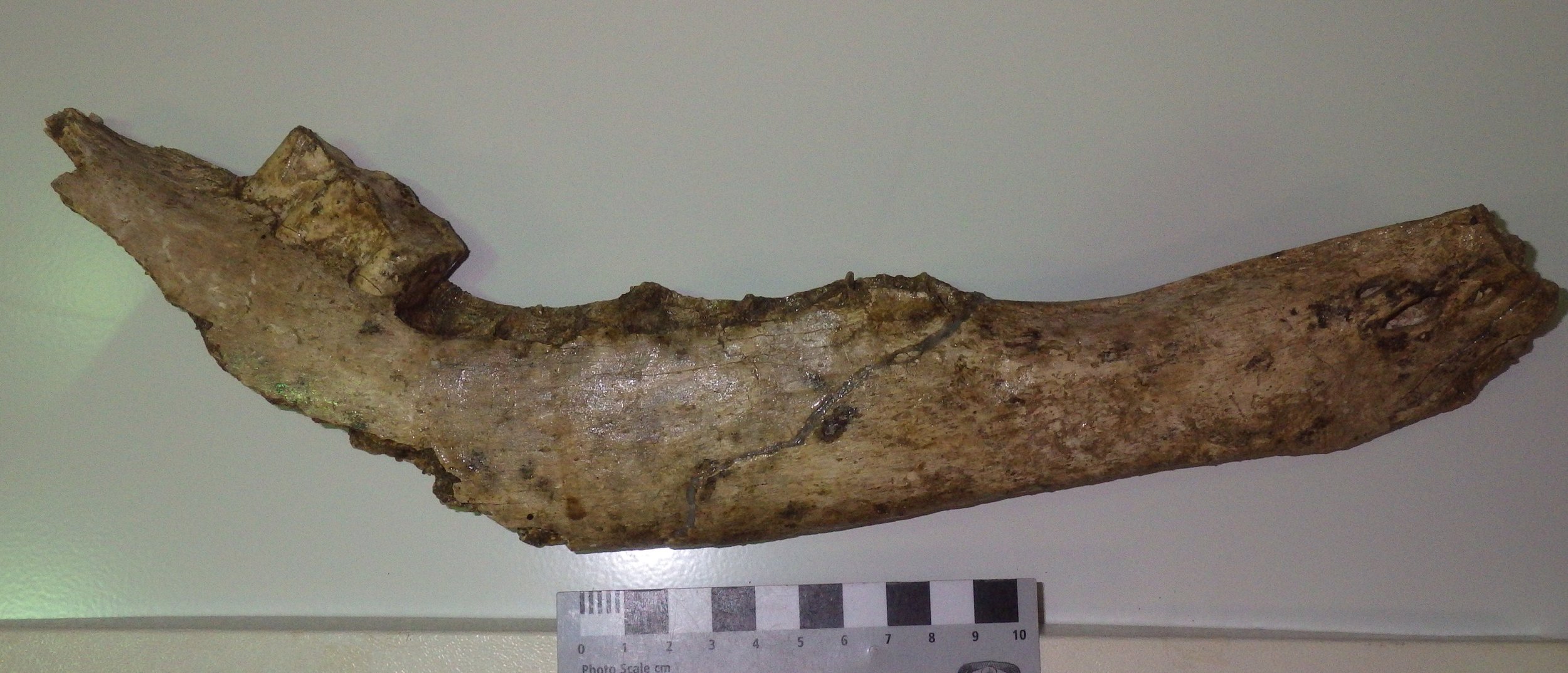 I'm in Chicago this week for the National Science Teachers' Association meeting, in part so that my wife Brett and I can demonstrate teaching kits that we're developing based on the WSC collections (I'll have more about those in a future post). One of these teaching kits involves fossil bison, including the specimen featured in today's Fossil Friday. This is a partial right lower jaw from a bison, seen above in lateral (side) view. Below is the same specimen from above (dorsal view):
I'm in Chicago this week for the National Science Teachers' Association meeting, in part so that my wife Brett and I can demonstrate teaching kits that we're developing based on the WSC collections (I'll have more about those in a future post). One of these teaching kits involves fossil bison, including the specimen featured in today's Fossil Friday. This is a partial right lower jaw from a bison, seen above in lateral (side) view. Below is the same specimen from above (dorsal view):
 While most of this jaw is missing, it does preserve the tooth sockets ("alveolae"), even though only a single tooth is preserved. That tooth is the last molar, m3, and it's pretty unusual in occlusal view:
While most of this jaw is missing, it does preserve the tooth sockets ("alveolae"), even though only a single tooth is preserved. That tooth is the last molar, m3, and it's pretty unusual in occlusal view:
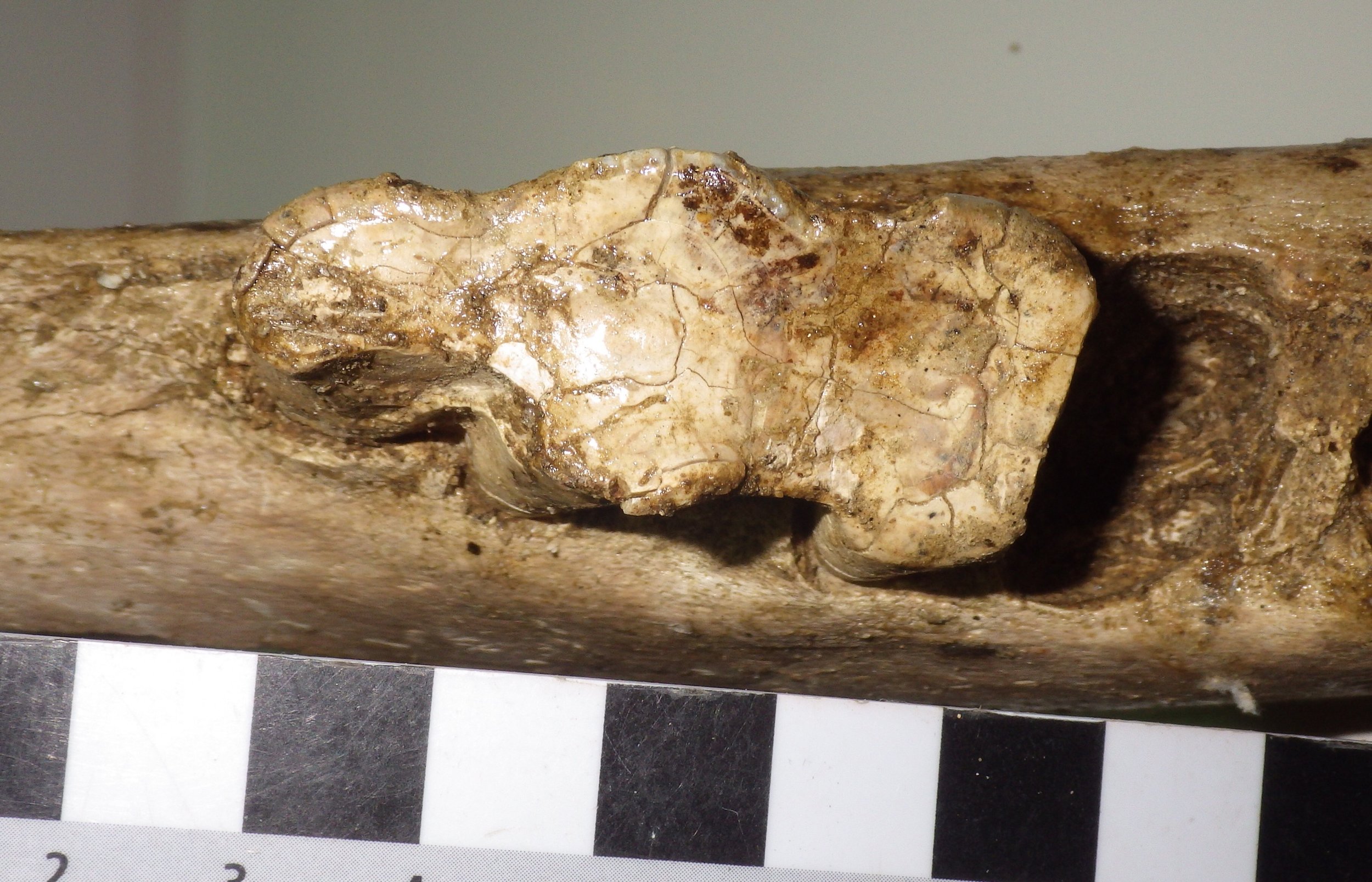 The tooth is almost completely worn away. None of the usual complex enamel patterns that we see in bison teeth are present, because the enamel is mostly gone, except for a few patches on the edges of the tooth. Modern bison live to about 15 years in the wild, and this one had to be getting up there.But there's actually more to look at here. It's not that unusual to have a jaw fragment with only one tooth preserved; once a jaw is broken it's easy for the teeth to fall out. But if we look at the empty tooth sockets in this jaw, we can see that's not what happened here:
The tooth is almost completely worn away. None of the usual complex enamel patterns that we see in bison teeth are present, because the enamel is mostly gone, except for a few patches on the edges of the tooth. Modern bison live to about 15 years in the wild, and this one had to be getting up there.But there's actually more to look at here. It's not that unusual to have a jaw fragment with only one tooth preserved; once a jaw is broken it's easy for the teeth to fall out. But if we look at the empty tooth sockets in this jaw, we can see that's not what happened here:
 These sockets actually have bone covering the openings. That means that the teeth fell out before the animal died, and the sockets healed over! This bison was shockingly old; it had actually lived long enough for every tooth except the last one wear all the way down to the roots and fall out, with the sockets healing over. Even the last tooth was close to falling out when the animal died.It's tough to estimate the age of such an old animal, but this had to be a particularly elderly individual, and has resulted in us nicknaming it "Methuselah".
These sockets actually have bone covering the openings. That means that the teeth fell out before the animal died, and the sockets healed over! This bison was shockingly old; it had actually lived long enough for every tooth except the last one wear all the way down to the roots and fall out, with the sockets healing over. Even the last tooth was close to falling out when the animal died.It's tough to estimate the age of such an old animal, but this had to be a particularly elderly individual, and has resulted in us nicknaming it "Methuselah".
Fossil Friday - horse pelvis
 For this week's Fossil Friday we have the pelvic bones from a horse, collected from the Pleistocene deposits at the east end of Diamond Valley Lake.In most tetrapods (four-legged vertebrates that mostly live on land, and their descendants) the pelvic girdle is the primary structure for supporting the animal's weight and allowing it to move. As such this is usually a large complex structure made up of six separate bones (three on each side) plus several specialized, fused vertebrae (the sacrals). The pelvic bones are the ilium, the ischium, and the pubis, and in mammals these are usually fused to each other at a young age; the fused group of three bones is called the innominate.The field jacket shown above actually has portions of both the left and right innominates of a horse. The bone on the right side of the image is the left innominate, seen in dorsal view (from above), while the one on the left is the right innominate, seen in ventral view (from below). Below is a color-coded version of the same image:
For this week's Fossil Friday we have the pelvic bones from a horse, collected from the Pleistocene deposits at the east end of Diamond Valley Lake.In most tetrapods (four-legged vertebrates that mostly live on land, and their descendants) the pelvic girdle is the primary structure for supporting the animal's weight and allowing it to move. As such this is usually a large complex structure made up of six separate bones (three on each side) plus several specialized, fused vertebrae (the sacrals). The pelvic bones are the ilium, the ischium, and the pubis, and in mammals these are usually fused to each other at a young age; the fused group of three bones is called the innominate.The field jacket shown above actually has portions of both the left and right innominates of a horse. The bone on the right side of the image is the left innominate, seen in dorsal view (from above), while the one on the left is the right innominate, seen in ventral view (from below). Below is a color-coded version of the same image:
 The bones outlined in blue are the ilia; he right ilium is damaged but the left one is largely intact. The yellow outlines mark the ischia, and the red is the pubis. Only the right pubis is visible; the left one is either hidden underneath the ilium and ischium or (more likely) not preserved at all.Where the three bones come together they form a cavity called the acetabulum, outlined in green. This is the "socket" part of the hip's "ball-and-socket" joint where the leg attaches to the hip. There is also a large gap between the pubis and the ischium called the obturator foramen, which serves as a passageway for nerves and blood vessels that run through the pelvis.While there is a lot of variation is the details, all mammals that have back legs share this same basic hip structure, and even mammals that lack back legs (such as whales and sea cows) had ancestors with similar pelvic bones.
The bones outlined in blue are the ilia; he right ilium is damaged but the left one is largely intact. The yellow outlines mark the ischia, and the red is the pubis. Only the right pubis is visible; the left one is either hidden underneath the ilium and ischium or (more likely) not preserved at all.Where the three bones come together they form a cavity called the acetabulum, outlined in green. This is the "socket" part of the hip's "ball-and-socket" joint where the leg attaches to the hip. There is also a large gap between the pubis and the ischium called the obturator foramen, which serves as a passageway for nerves and blood vessels that run through the pelvis.While there is a lot of variation is the details, all mammals that have back legs share this same basic hip structure, and even mammals that lack back legs (such as whales and sea cows) had ancestors with similar pelvic bones.
Fossil Friday - juvenile mastodon femur
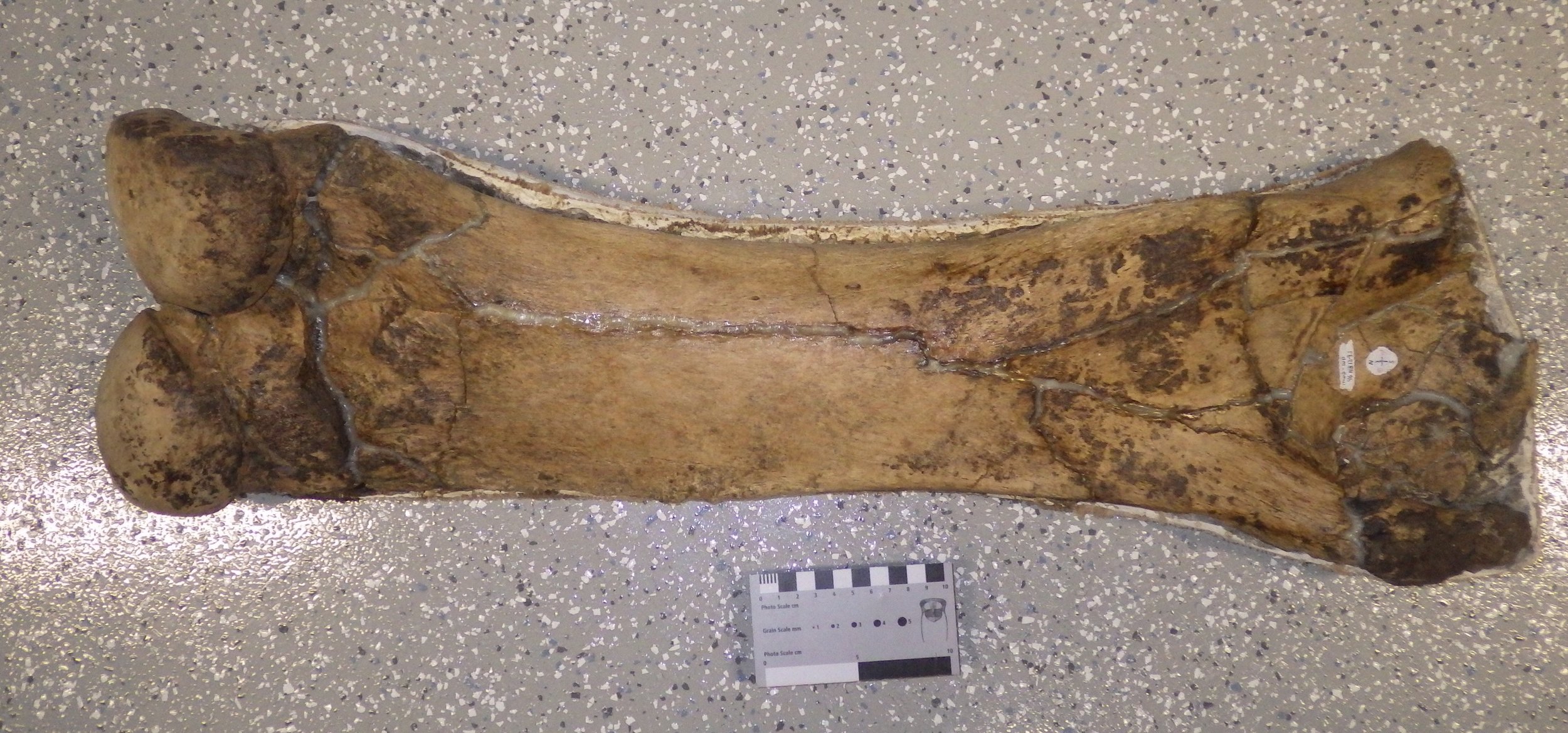 This week's Fossil Friday specimen is a femur (thigh bone) from a mastodon, collected from the West Dam of Diamond Valley Lake.Like many of the Western Science Center specimens, this femur is only partially prepared, and still sits in its field jacket. The posterior side of the bone is shown above, with the back of the knee joint visible on the left. As this is the right femur, there should be a large ball joint (the femoral head) in the upper right, that would articulate with the hip socket. Unfortunately the femoral head was broken off and not preserved.The preserved part of this bone is roughly 70 cm long. That's actually pretty small for a mastodon, large specimens of which can have femora more than a meter in length. This was probably a sub-adult mastodon, although the partial fusion of the knee joint to the rest of the bone suggests that it wasn't too young.
This week's Fossil Friday specimen is a femur (thigh bone) from a mastodon, collected from the West Dam of Diamond Valley Lake.Like many of the Western Science Center specimens, this femur is only partially prepared, and still sits in its field jacket. The posterior side of the bone is shown above, with the back of the knee joint visible on the left. As this is the right femur, there should be a large ball joint (the femoral head) in the upper right, that would articulate with the hip socket. Unfortunately the femoral head was broken off and not preserved.The preserved part of this bone is roughly 70 cm long. That's actually pretty small for a mastodon, large specimens of which can have femora more than a meter in length. This was probably a sub-adult mastodon, although the partial fusion of the knee joint to the rest of the bone suggests that it wasn't too young.
Fossil Friday - amber snails
 Worldwide, easily the most common fossils are from marine invertebrates. Most sedimentary rocks are formed in the ocean, invertebrates are present in vast numbers, and the ocean is an excellent place to be buried in the mud, increasing the likelihood of being preserved. In contrast, the fossil collections at the Western Science Center are dominated by terrestrial deposits from Riverside County, so most of our fossils are land vertebrates. We do, however, have a pretty good collection of terrestrial and freshwater invertebrates in the collections.Above is the shell of an amber snail (Gastropoda) from the genus Succinea. Amber snails are air-breathing snails (they have lungs) that generally live in marshy areas. The genus is wide-ranging, and modern Succinea are found all over North America. Below is the same shell in a different orientation, showing the aperture (the opening to the inside of the shell):
Worldwide, easily the most common fossils are from marine invertebrates. Most sedimentary rocks are formed in the ocean, invertebrates are present in vast numbers, and the ocean is an excellent place to be buried in the mud, increasing the likelihood of being preserved. In contrast, the fossil collections at the Western Science Center are dominated by terrestrial deposits from Riverside County, so most of our fossils are land vertebrates. We do, however, have a pretty good collection of terrestrial and freshwater invertebrates in the collections.Above is the shell of an amber snail (Gastropoda) from the genus Succinea. Amber snails are air-breathing snails (they have lungs) that generally live in marshy areas. The genus is wide-ranging, and modern Succinea are found all over North America. Below is the same shell in a different orientation, showing the aperture (the opening to the inside of the shell):
 Succinea is a tiny snail; the black box the shell is sitting on in the images is only 1 cm across! A fairly large number of Succinea shells were recovered in the Pleistocene deposits from Diamond Valley Lake.
Succinea is a tiny snail; the black box the shell is sitting on in the images is only 1 cm across! A fairly large number of Succinea shells were recovered in the Pleistocene deposits from Diamond Valley Lake.
Fossil Friday - Bison antiquus skull
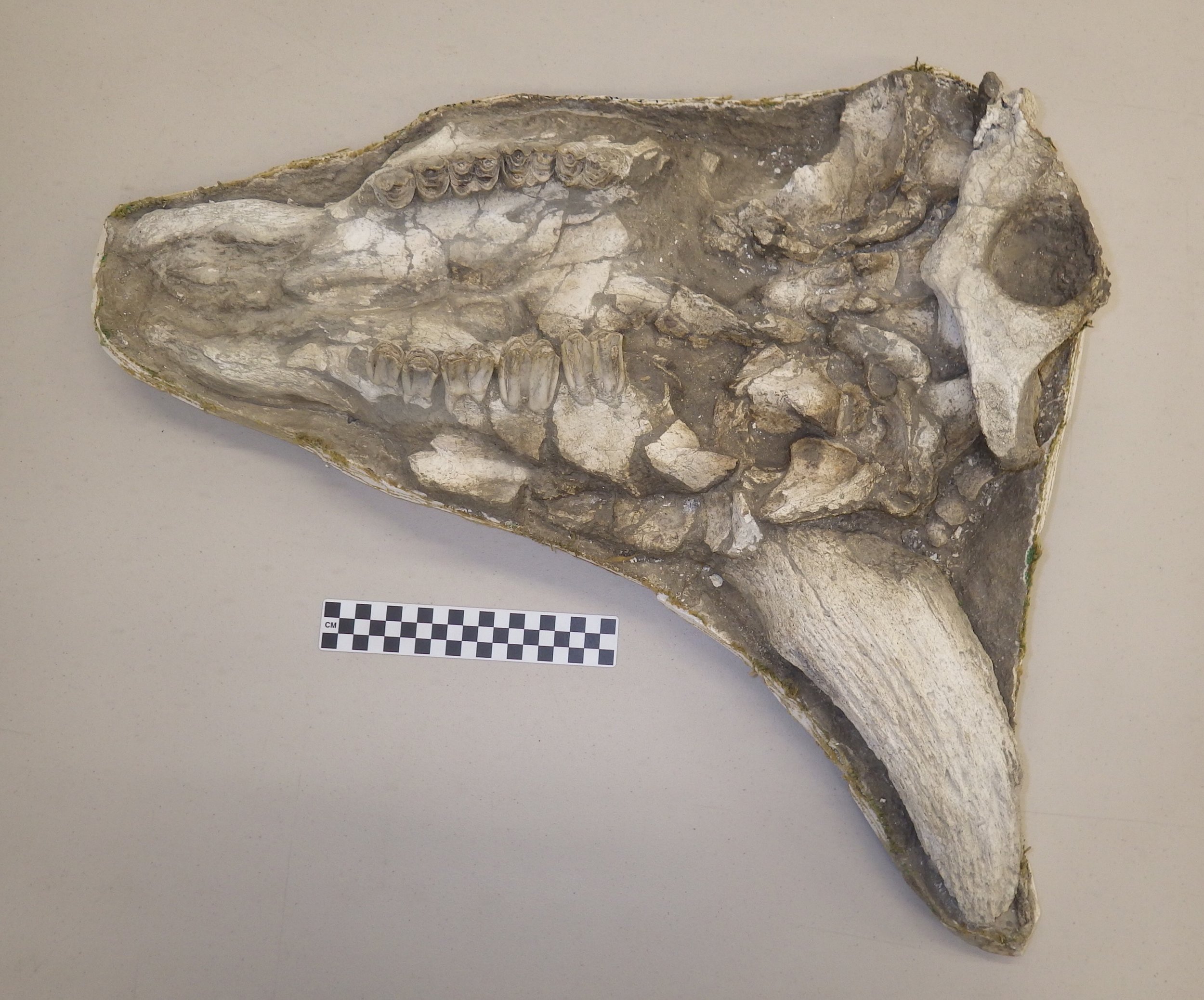 Bison are among the most common large animals from the Diamond Valley Lake region, and we have a number of nice specimens at the Western Science Center. Shown above is a cranium of Bison antiquus, one of several such skulls in our collection.This skull, while incomplete, is in pretty good shape. It's still in its field jacket, and only partially prepared, so only the ventral (bottom) side is visible. The front of the skull is to the left. The left horn core is noticeably missing, and there is some crushing of the skull that's most clearly visible along the right side (bottom of the image). The 2nd premolar is missing on each side, but the other teeth are all present. If you're looking carefully, you might have noticed that there are no incisor teeth in the front of the mouth. Bison don't have incisors in the upper jaws, a character they share with other "horned ruminants" (Infraorder Pecora). The mass of bone at the back of the skull (on the right side of the image) is the atlas (first neck vertebra), more-or-less still attached to the skull.There are two different species of bison present in the Pleistocene deposits at Diamond Valley Lake, the smaller Bison antiquus and the larger, longer-horned Bison latifrons. (When I say "smaller", that's relative; B. antiquus was still larger than modern bison.) Bison antiquus seems to be the more common of the two fossil species in this area. It's generally thought that B. antiquus is the direct ancestor to the modern bison, Bison bison.
Bison are among the most common large animals from the Diamond Valley Lake region, and we have a number of nice specimens at the Western Science Center. Shown above is a cranium of Bison antiquus, one of several such skulls in our collection.This skull, while incomplete, is in pretty good shape. It's still in its field jacket, and only partially prepared, so only the ventral (bottom) side is visible. The front of the skull is to the left. The left horn core is noticeably missing, and there is some crushing of the skull that's most clearly visible along the right side (bottom of the image). The 2nd premolar is missing on each side, but the other teeth are all present. If you're looking carefully, you might have noticed that there are no incisor teeth in the front of the mouth. Bison don't have incisors in the upper jaws, a character they share with other "horned ruminants" (Infraorder Pecora). The mass of bone at the back of the skull (on the right side of the image) is the atlas (first neck vertebra), more-or-less still attached to the skull.There are two different species of bison present in the Pleistocene deposits at Diamond Valley Lake, the smaller Bison antiquus and the larger, longer-horned Bison latifrons. (When I say "smaller", that's relative; B. antiquus was still larger than modern bison.) Bison antiquus seems to be the more common of the two fossil species in this area. It's generally thought that B. antiquus is the direct ancestor to the modern bison, Bison bison.
Fossil Friday - horse thoracic vertebrae
 Our Fossil Friday specimen for this week is a pair of Pleistocene horse vertebrae, still in their field jacket.These two vertebrae are the sixth and seventh thoracics (see this link for an overview of vertebral regions in mammals). In the image the bottoms of the vertebrae are to the left and the tops are to the right. The sixth thoracic is the upper of the two, and you're looking at the posterior surface. In contrast, anterior surface of the seventh thoracic is visible. In the articulated skeleton these vertebrae lie roughly adjacent to the shoulder blades, as shown below in this mounted skeleton at the Texas Memorial Museum:
Our Fossil Friday specimen for this week is a pair of Pleistocene horse vertebrae, still in their field jacket.These two vertebrae are the sixth and seventh thoracics (see this link for an overview of vertebral regions in mammals). In the image the bottoms of the vertebrae are to the left and the tops are to the right. The sixth thoracic is the upper of the two, and you're looking at the posterior surface. In contrast, anterior surface of the seventh thoracic is visible. In the articulated skeleton these vertebrae lie roughly adjacent to the shoulder blades, as shown below in this mounted skeleton at the Texas Memorial Museum:
 The long projections coming from the top of each vertebra are called "neural spines" or "spinous processes". They are rather tall in horses, especially in the anterior half of the thoracic region. These tall processes form the horse's withers, the hump present above the shoulders:
The long projections coming from the top of each vertebra are called "neural spines" or "spinous processes". They are rather tall in horses, especially in the anterior half of the thoracic region. These tall processes form the horse's withers, the hump present above the shoulders:
 Tall neural spines are present in lots of different animals, and can serve a variety of functions including display and supporting fat bodies. They're pretty much always present in land mammals like horses that have large, heavy heads. Horses spend the vast majority of their time in a posture like the one in the image above; head to the ground, eating. It's hard to keep balanced with that heavy head stuck out like that, and ligaments that run along the neural spines transfer much of the load throughout the vertebral column. The neural spines also serve as attachment points for muscles that move and support the head, neck, and shoulders.These two vertebrae were collected in 1997 near the east dam of Diamond Valley Lake.
Tall neural spines are present in lots of different animals, and can serve a variety of functions including display and supporting fat bodies. They're pretty much always present in land mammals like horses that have large, heavy heads. Horses spend the vast majority of their time in a posture like the one in the image above; head to the ground, eating. It's hard to keep balanced with that heavy head stuck out like that, and ligaments that run along the neural spines transfer much of the load throughout the vertebral column. The neural spines also serve as attachment points for muscles that move and support the head, neck, and shoulders.These two vertebrae were collected in 1997 near the east dam of Diamond Valley Lake.
Fossil Friday - baby mastodon teeth
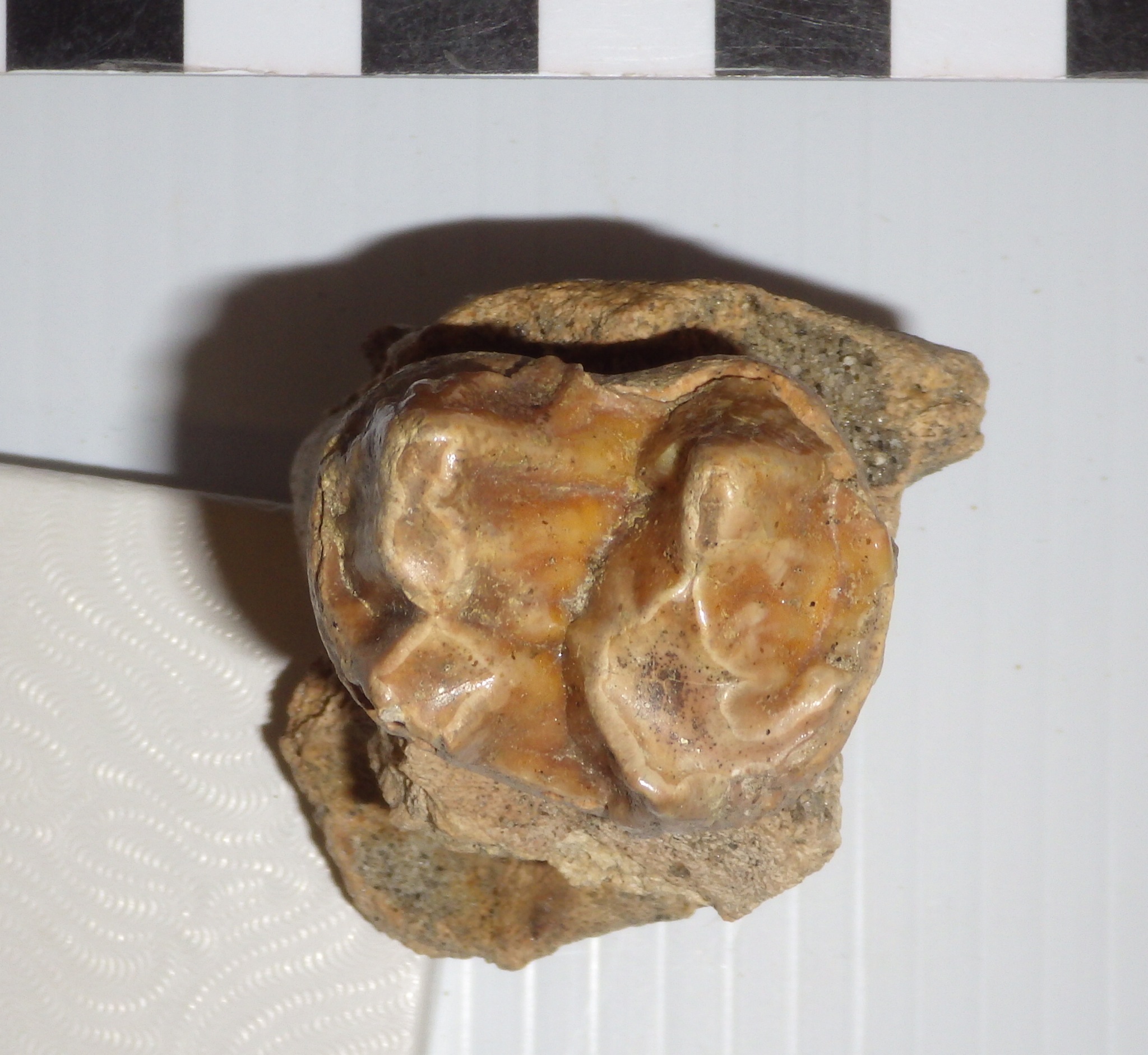 It seems that most of the mastodon remains from Diamond Valley Lake are from adult or nearly adult animals, although there are exceptions representing younger animals. Then we have the example shown here, from an almost ridiculously cute baby mastodon.This tooth is the upper right second premolar (dP2), the very first upper tooth to erupt in mastodons. It's shown above in occlusal view, with the front of the tooth to the left. Mastodon teeth have distinctive transverse ridges of enamel (they're what make tooth look "bumpy"), and the number of ridges differs by tooth position. Typically the second and third premolars each have two ridges, the fourth premolar and first two molars each have three, and the third molar has five. The two ridges in this tooth make it either a second or third premolar, but its size gives away its position; this tooth is only 31 mm long! This puts it squarely in the size range of dP2 specimens from Florida described by Green and Hulbert (2005), which ranged from 27.6 to 36.4 mm. To get an idea of just how tiny this tooth is, here it is beside a mastodon third molar:
It seems that most of the mastodon remains from Diamond Valley Lake are from adult or nearly adult animals, although there are exceptions representing younger animals. Then we have the example shown here, from an almost ridiculously cute baby mastodon.This tooth is the upper right second premolar (dP2), the very first upper tooth to erupt in mastodons. It's shown above in occlusal view, with the front of the tooth to the left. Mastodon teeth have distinctive transverse ridges of enamel (they're what make tooth look "bumpy"), and the number of ridges differs by tooth position. Typically the second and third premolars each have two ridges, the fourth premolar and first two molars each have three, and the third molar has five. The two ridges in this tooth make it either a second or third premolar, but its size gives away its position; this tooth is only 31 mm long! This puts it squarely in the size range of dP2 specimens from Florida described by Green and Hulbert (2005), which ranged from 27.6 to 36.4 mm. To get an idea of just how tiny this tooth is, here it is beside a mastodon third molar:
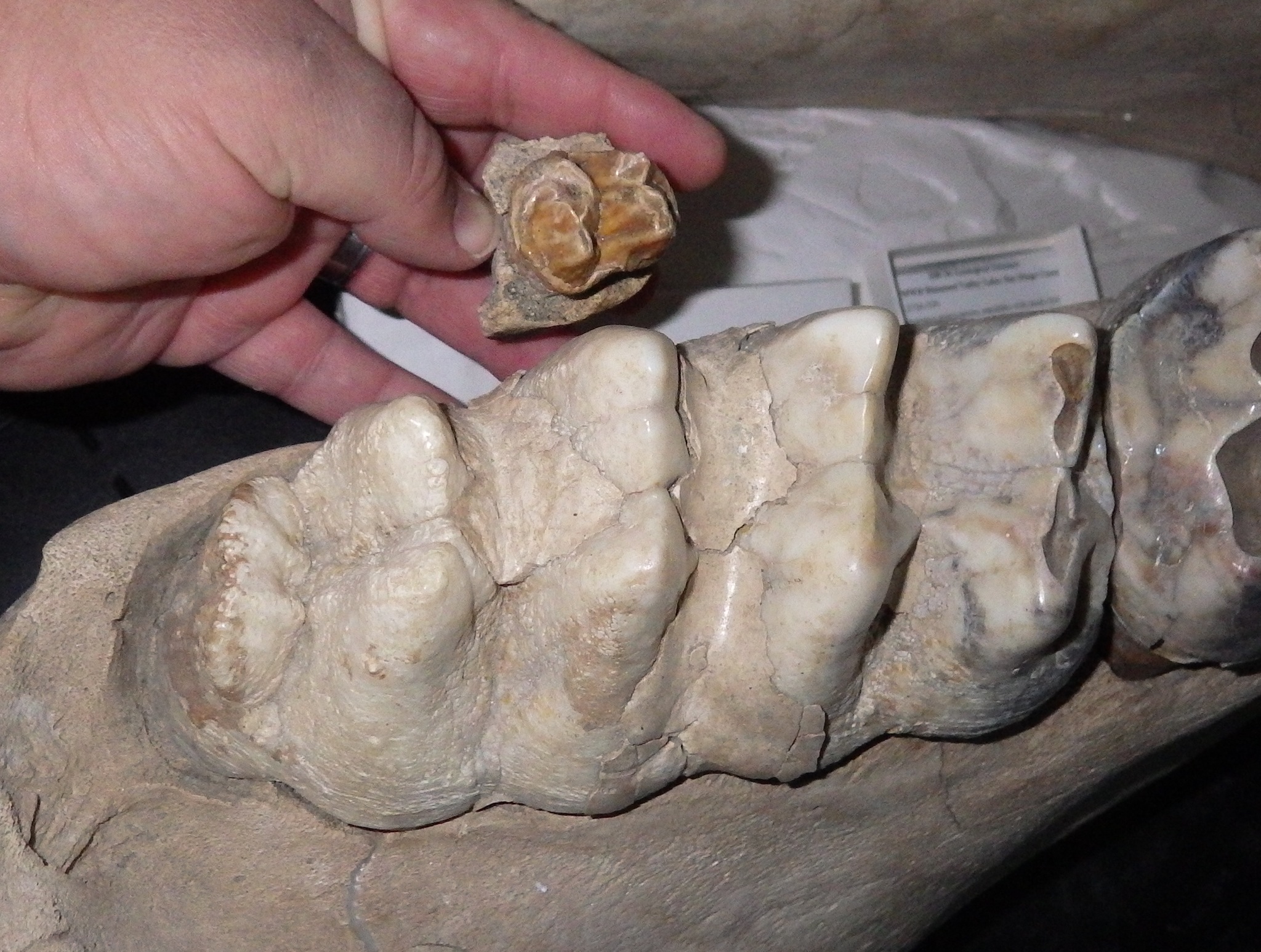 Here's a labial (side) view of the premolar:
Here's a labial (side) view of the premolar:
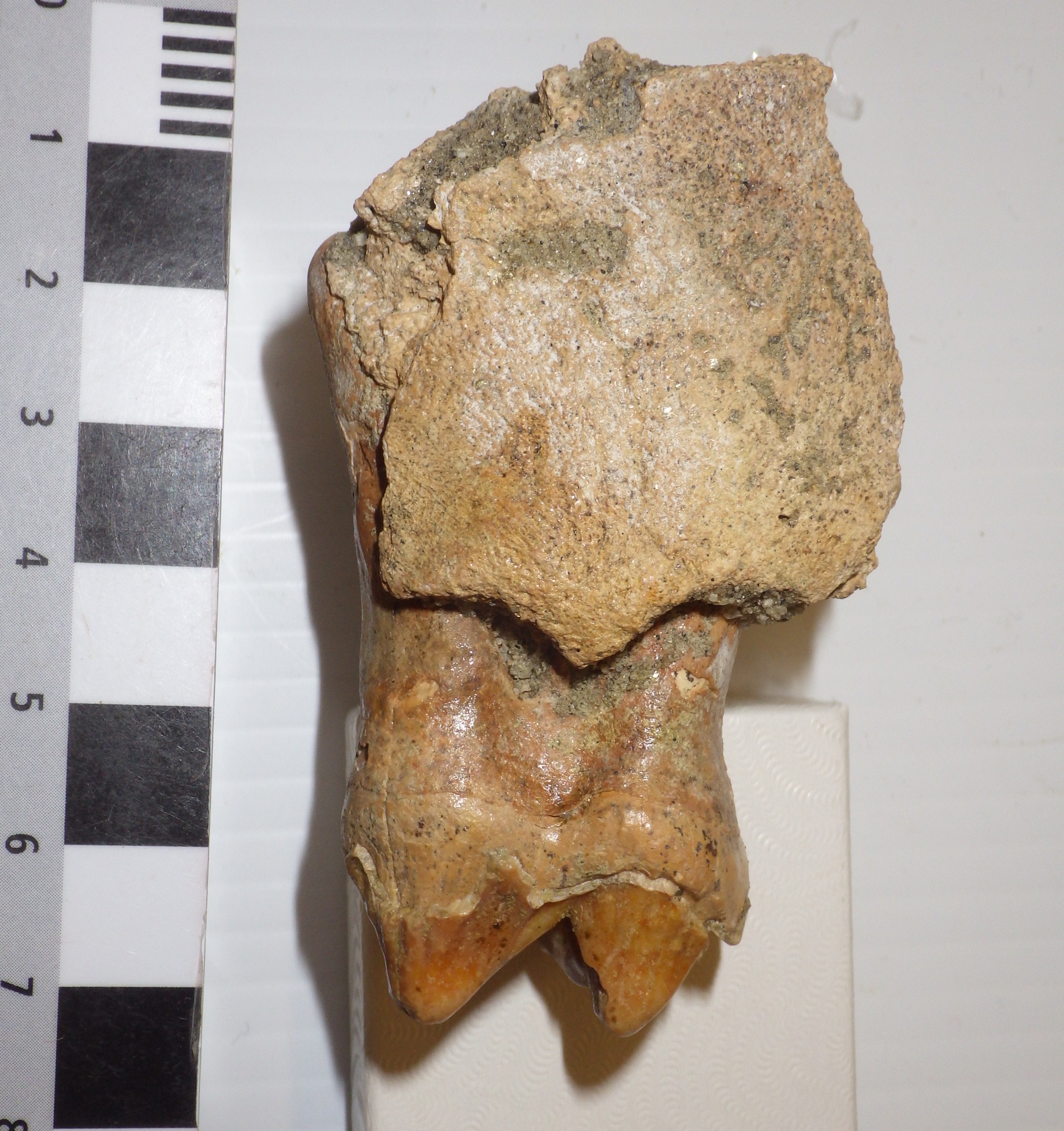 This tooth was discovered near the West Dam in December 1997. It turns out that some other baby mastodon teeth were found at the same site three days earlier. While they have separate numbers in the collection, it's very likely that these teeth all came from one animal. The additional material includes the left maxilla fragment below, shown in labial view with the front toward the left:
This tooth was discovered near the West Dam in December 1997. It turns out that some other baby mastodon teeth were found at the same site three days earlier. While they have separate numbers in the collection, it's very likely that these teeth all came from one animal. The additional material includes the left maxilla fragment below, shown in labial view with the front toward the left:
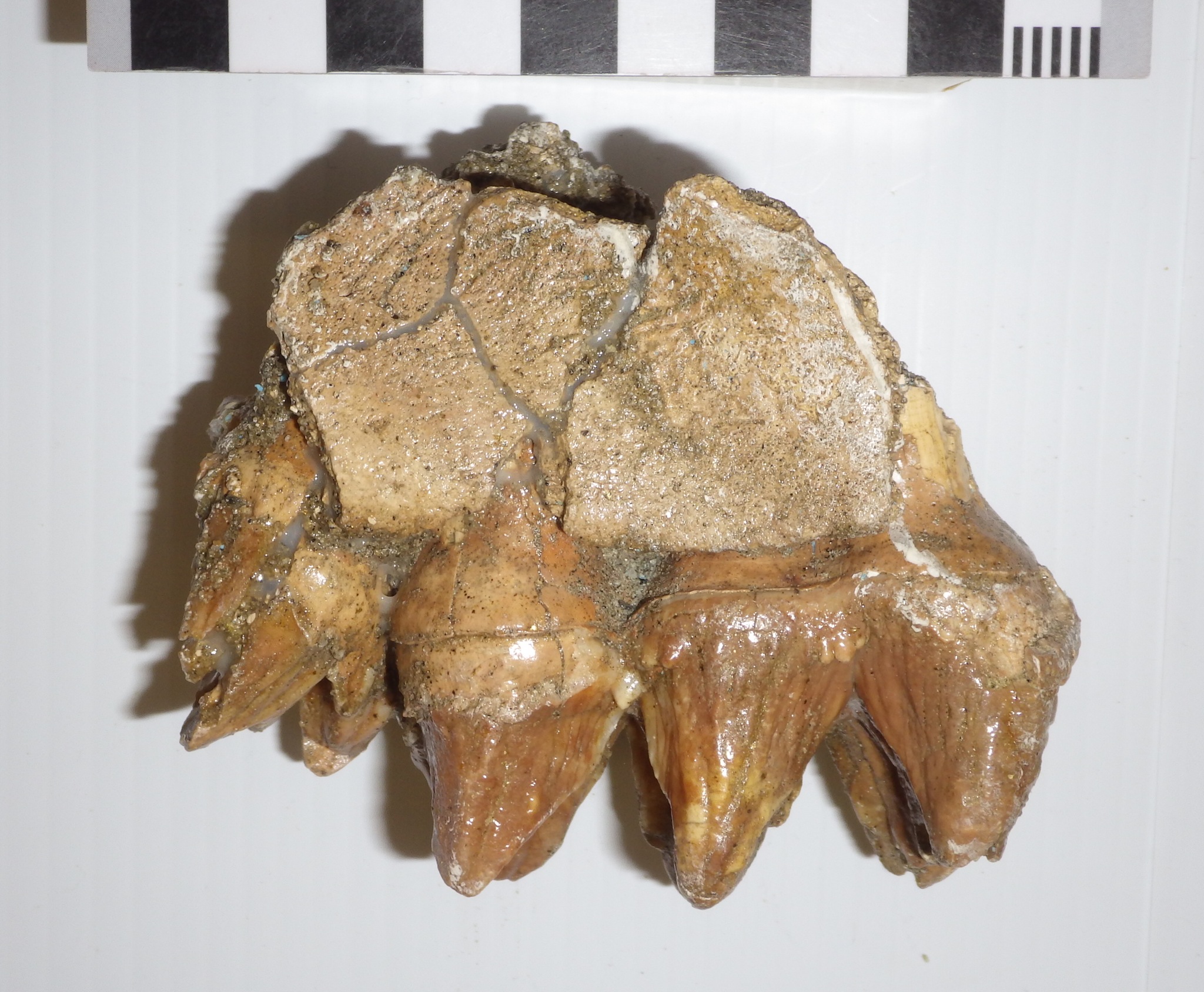 Here's the same fragment in occlusal view, again with the front toward the left:
Here's the same fragment in occlusal view, again with the front toward the left:
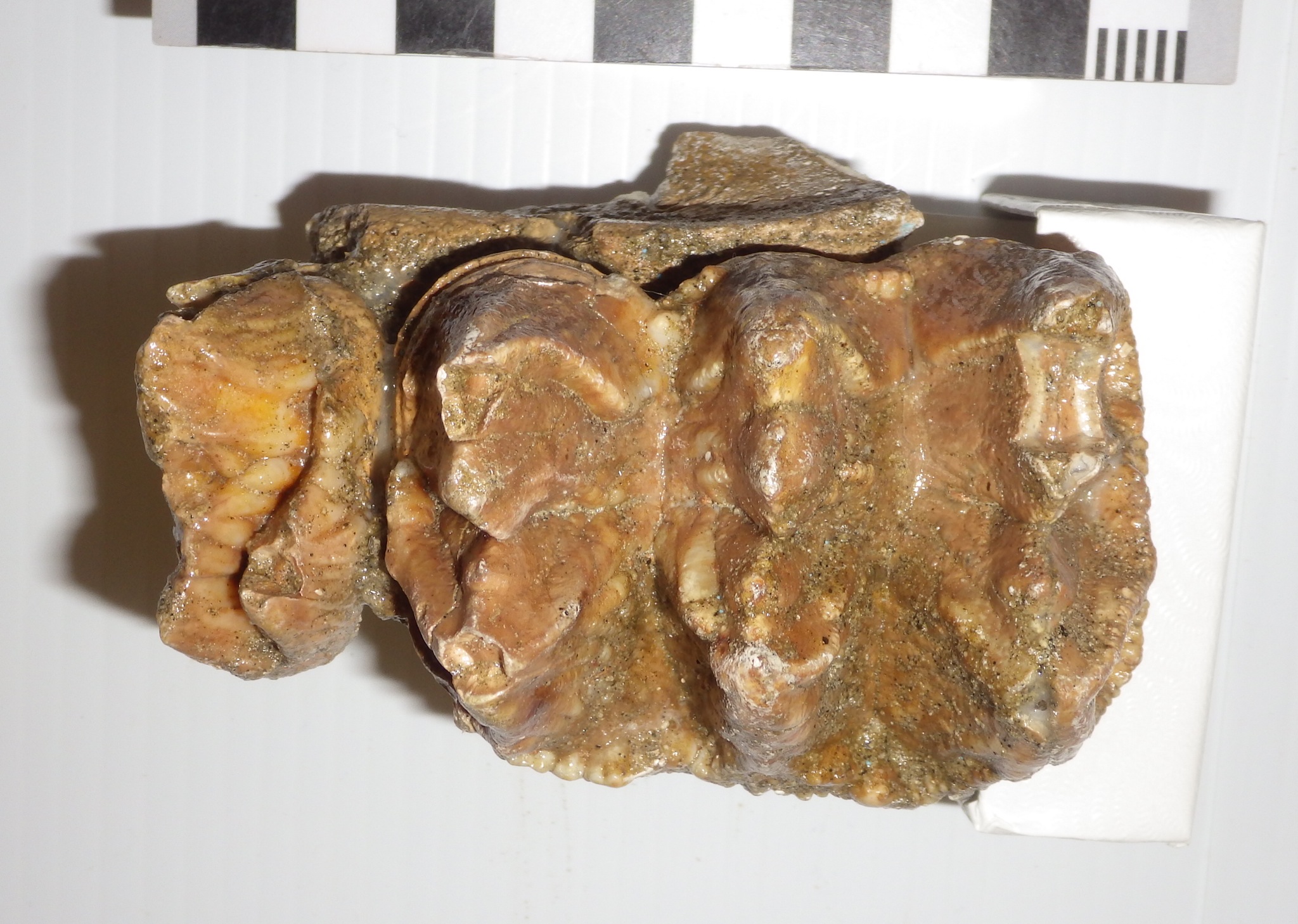 The larger, complete tooth is the fourth premolar (note the three transverse enamel ridges). In front of it is the posterior ridge of the third premolar.The fragmentary right fourth premolar was also collected (occlusal view, anterior to the right):
The larger, complete tooth is the fourth premolar (note the three transverse enamel ridges). In front of it is the posterior ridge of the third premolar.The fragmentary right fourth premolar was also collected (occlusal view, anterior to the right):
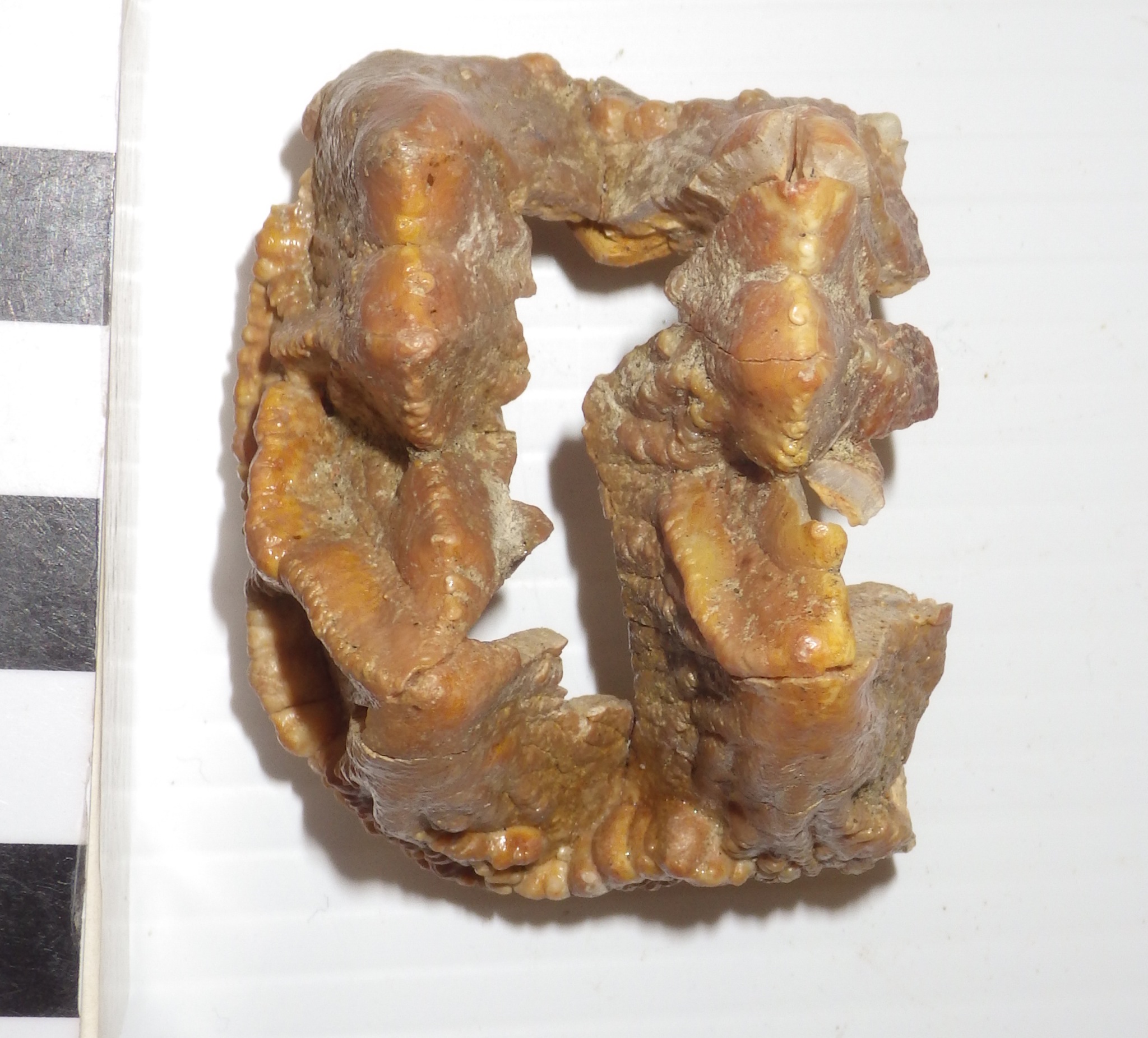 If all these pieces came from one individual (which I think is very likely), we have almost the entire upper left premolar series, lacking only the front half of the third premolar, as well as part of one right premolar.So I called this a baby mastodon, but how young was it? We can estimate the age if we assume that mastodon growth rates and tooth eruption times were similar to those of modern elephants. Mastodonts and elephants are only distantly related, so undoubtedly this introduces some uncertainty, but given their similar sizes and tooth replacement patterns it should produce a reasonable estimate.A key feature to look at is the amount of wear on each tooth. The fourth premolars and the preserved part of the third premolar show no wear at all. But in the second premolar, while the enamel ridges are mostly intact, there is a little wear at the tips (this is most clearly visible in the occlusal view at the top). In African elephants, the second premolar begins to wear when the elephant is about 2 months old, and by the age of 2 years the tooth has worn down and fallen out. Given the light wear present on this tooth, this mastodon was likely no more than 4 to 6 months old!Reference: Green, J. L. And R. C. Hulbert, Jr. 2005. The deciduous premolars of Mammut americanum (Mammalia, Proboscidea). Journal of Vertebrate Paleontology 25:702-715.
If all these pieces came from one individual (which I think is very likely), we have almost the entire upper left premolar series, lacking only the front half of the third premolar, as well as part of one right premolar.So I called this a baby mastodon, but how young was it? We can estimate the age if we assume that mastodon growth rates and tooth eruption times were similar to those of modern elephants. Mastodonts and elephants are only distantly related, so undoubtedly this introduces some uncertainty, but given their similar sizes and tooth replacement patterns it should produce a reasonable estimate.A key feature to look at is the amount of wear on each tooth. The fourth premolars and the preserved part of the third premolar show no wear at all. But in the second premolar, while the enamel ridges are mostly intact, there is a little wear at the tips (this is most clearly visible in the occlusal view at the top). In African elephants, the second premolar begins to wear when the elephant is about 2 months old, and by the age of 2 years the tooth has worn down and fallen out. Given the light wear present on this tooth, this mastodon was likely no more than 4 to 6 months old!Reference: Green, J. L. And R. C. Hulbert, Jr. 2005. The deciduous premolars of Mammut americanum (Mammalia, Proboscidea). Journal of Vertebrate Paleontology 25:702-715.
Fossil Friday - pocket gopher skull
 While the Pleistocene deposits from Diamond Valley Lake have lots of big impressive animals, small animals are actually much more numerous. The most common mammal in "The Valley of the Mastodons" is the pocket gopher!While most of our pocket gopher (genus Thomomys) remains are isolated teeth, there are a few more substantial specimens including the partial cranium shown here. At top is the skull in dorsal (top) view, with the front of the skull to the left. Most of the back and left side of the skull is missing, but the front and part of the right side are in pretty good shape. The ring of bone on the right side of the skull (at the top of the image) is made up of mostly of the jugal and the zygomatic process of the squamosal. Together these bones form the outer margin of the orbit (eye socket) and the temporal fossa, an opening for the muscles that close the lower jaw.Below is a lateral view, showing the right side of the cranium:
While the Pleistocene deposits from Diamond Valley Lake have lots of big impressive animals, small animals are actually much more numerous. The most common mammal in "The Valley of the Mastodons" is the pocket gopher!While most of our pocket gopher (genus Thomomys) remains are isolated teeth, there are a few more substantial specimens including the partial cranium shown here. At top is the skull in dorsal (top) view, with the front of the skull to the left. Most of the back and left side of the skull is missing, but the front and part of the right side are in pretty good shape. The ring of bone on the right side of the skull (at the top of the image) is made up of mostly of the jugal and the zygomatic process of the squamosal. Together these bones form the outer margin of the orbit (eye socket) and the temporal fossa, an opening for the muscles that close the lower jaw.Below is a lateral view, showing the right side of the cranium:
 The long, curved shiny feature at the front of the skull (on the right side of the photo) are the incisor teeth. The presence of a single pair of enlarged, ever-growing incisors is a feature shared among all rodents. Unlike other gophers, in Thomomys the incisors are smooth and lack longitudinal ridges (one common name for Thomomys is the "smooth toothed pocket gopher").Here is the ventral (bottom) side of the skull:
The long, curved shiny feature at the front of the skull (on the right side of the photo) are the incisor teeth. The presence of a single pair of enlarged, ever-growing incisors is a feature shared among all rodents. Unlike other gophers, in Thomomys the incisors are smooth and lack longitudinal ridges (one common name for Thomomys is the "smooth toothed pocket gopher").Here is the ventral (bottom) side of the skull:
 While there' some damage present here, and some cleaning is still needed, it looks like most of the tooth row is preserved. The complex tooth at the front of the row is the fourth premolar, while the large peg-like tooth that is partially sticking out of its socket is either the second or third molar.Pocket gophers are still common in western North America. As burrowing animals, their preservation potential is pretty high; it's a lot easier to become a fossil if you already live most of your life underground!
While there' some damage present here, and some cleaning is still needed, it looks like most of the tooth row is preserved. The complex tooth at the front of the row is the fourth premolar, while the large peg-like tooth that is partially sticking out of its socket is either the second or third molar.Pocket gophers are still common in western North America. As burrowing animals, their preservation potential is pretty high; it's a lot easier to become a fossil if you already live most of your life underground!

